REGIONAL AIRPORTS INSIDE:





A business barometer released before Christmas showed that despite the Autumn budget, confidence in the economy is growing
Businesses spoke with almost one voice after the budget to condemn the government’s unexpected raising of the employer’s National Insurance.
Shevaun Haviland, Director General of the British Chambers of Commerce, said: “The increase in employer National Insurance Contributions will place a further cost burden on business.”
Regional groups such as Coventry & Warwickshire Chamber of Commerce were more willing to take a longer view. “Businesses in Coventry and Warwickshire will ‘take the hit’ of the Chancellor’s budget in the hope that it leads to long term stability and growth in the economy,” it said.
Business West, which represents businesses across Swindon and North Wiltshire, Gloucestershire, Bristol and Bath, was punchier. Managing Director Phil Smith said: “We recognise that the government faces a tight fiscal position and had to make hard decisions. However, raising the business community’s tax burden could hinder the government’s much sought after growth and undermine investment decisions.”
But what do the businesses themselves think? According to the December Lloyds Bank Business Barometer, the wellrespected monthly survey of business sentiment, while there are certainly fears about the health of the UK economy (which caused business confidence to fall in November), companies appear upbeat about their longer-term prospects.
That’s a good way to go into 2025 – the year of the snake, according to the Chinese calendar. Apparently the snake is often

Nicky Godding Editor
The increase in employer
will place a further cost burden on business
seen as a symbol of transformation and adaptability. Another good sign.
How can businesses grow this year?
Collaboration across the region is a good start (there’s power in the collective) and investing in skills (see our feature on apprenticeships). Face to face networking creates long term business relationships, and the government wants more companies expanding through exporting.
Many seek external investment. But be warned, the entrepreneurs I talk to say it’s critical to select the right investors who are either in or understand your industry. The wrong investment could be worse than no investment.
In this issue we look at the opportunities to share wealth across the UK through investing in our regional airports.
We also interview Dame Clare Marchant, the new Vice Chancellor of the University of Gloucestershire who wants to set an example to other universities as it seeks to reboot its relationship with business. And put the spotlight on a Bristol business which is surveying the world’s ocean beds for a new generation of floating wind farms.
Here’s to a stable and successful 2025.


































































Selling good overseas as well as at home is a no-brainer. It significantly widens your customer base, and (Brexit aside), isn’t as difficult as some might think.
But not enough British companies do. Fewer than 12 per cent of UK companies export their goods or services says the government.
Total UK exports to the end of August last year were just shy of £856 billion, but this was a four per cent decrease.
So the government has announced some strategies to boost this figure. UK Export Finance (UKEF), the country’s export credit agency, introduced new help for British firms to secure international contracts. The Early Project Services Guarantee is now available to overseas buyers who use British services firms to scope and design their projects.
The guarantee helps overseas buyers of UK services to access private finance by assuring lenders that they will receive payment, making the UK offer more attractive.
Last November, while in Brazil for the G20 trade talks, our trade secretary Jonathan Reynolds launched a new £2.3 million fund to help companies unlock export opportunities worth nearly £5 billion for UK companies over five years.
To wrap up the year, in December the UK joined the Comprehensive and Progressive Agreement for TransPacific Partnership (CPTPP), a free trade agreement between Australia, Brunei Darussalam, Canada, Chile, Japan, Malaysia, Mexico, Peru, New Zealand, Singapore and Vietnam – and now the UK.
But some businesses are already showing the rest of us how it’s done.


A Cotswolds natural soap company is branching out into new markets at home and abroad.
Little Soap Company was founded in 2008 by Emma Heathcote-James to fill an untapped gap in the market –natural, pure soaps that are good for the skin and kind to the planet. Now, the company is focused on its next phase of expansion after securing a finance package from Lloyds.
From hand-making soaps in her kitchen and selling to local farmers’ markets, the business quickly upscaled, using UK factories to make their four brands –Organic, Naturals, Eco Warrior and Little Beast – supplying all major UK retailers. Its products now sit in the soap, haircare, shave, skincare, men’s, baby and child aisles. It also has a line of pet shampoos too.
The company’s commitment to sustainability is a key contributor to its popularity, with its Eco Warrior range winning the Queen’s Award for Enterprise Innovation in 2022.
Emma, her wife Sharon, and their team of 10 staff sell millions of products a year, through most major UK supermarket retailers, Amazon and Boots.
The funding package from Lloyds will support the installation of new, advanced software to enable greater automation of order fulfilment and forecasting.
This will make it faster and easier to process retailer and online orders and better integrate with manufacturing as the business grows in the UK and into international markets.
Little Soap Company is currently venturing into Taiwan, Netherlands and Ireland, and aims to enter the US and other areas of Europe.
The firm’s expansion will ensure it continues to achieve year-on-year growth while remaining profitable and founder-owned.
Emma said: “I was inspired to start the Little Soap Company by my gran, who built a collection of luxurious,



“I was inspired to start the Little Soap Company by my gran, who built a collection of luxurious, kind-toskin bar soaps while she travelled”


kind-to-skin bar soaps while she travelled. However, when I searched for similar organically produced products at home, the options were few and far between, uncovering the need for a planet-friendly range.
“I’ve banked with Lloyds since I was a teenager so when searching for a bank for the business, it was essential to find one that understood the brand and knew how to work with us, something that was important to me as a neurodivergent business owner.”
Jessica Fox, relationship manager at Lloyds, said: “Little Soap Company is an incredible business with a truly inspiring story. Its passion for creating eco-friendly, sustainable products has set a new standard in the industry, and its dedication to making a positive environmental impact is something we’re proud to support.
“We’ve worked closely with Emma and her team. Seeing the business grow from a local start-up to a successful national brand has been incredibly rewarding.”

Cheltenham drinks business toasts export success with £4.5m deal
A premium drinks producer in Cheltenham has secured £4.5 million in financing to support its global export of bespoke drinks packages, including to Asia.
Provided by HSBC, the package combines a finance facility of £3 million, and a trade finance facility of £1.5 million guaranteed by UKEF, the government export credit agency.
Founded by two friends, Matthew Maslin and Jim Denoon, Gravity Drinks already exports to the USA, Canada, Scandinavia, Taiwan, Japan and New Zealand.
The business designs and develops branded and private label products for sale into UK and international retailers and wholesalers.
Seasonal demand for its drinks means that the business required additional working capital to ramp up production in the run-up to Christmas, New Year and other seasonal celebrations.
The business has also used the finance to launch other new products and white
labelling for international customers in Asia. This has supported Gravity in its year-onyear revenue growth since it was founded in 2018, with a total order value of just under £8 million booked in 2024.
New financing also supports the business’s efforts to invest in new equipment and create new roles at its Cheltenham offices.
Jim said: “With continued demand from our customers in the UK and overseas, having the right partners in place to help finance our growth is crucial to our business. UK Export Finance have been supportive of us from the early days of Gravity.”
Hitesh Patel, Export Finance Manager for London at UK Export Finance, added: “It has been a pleasure working with Jim Denoon’s team to understand the financial and insurance needs of the business.
“Immersed in local markets, Gravity Drinks has taken the time to really understand local seasonal celebrations globally and tailored drinks solutions to capture their audience.”
Students from the University of Bath were pumped up after winning the Heart Hackathon – the world’s first total artificial heart design competition – for the second year in a row.
The team, comprising 70 students studying on engineering, science and management courses, created a device which could technically replace the entire job of a heart, and then attended the competition which was held in Japan.
Innovations used in their design included wireless charging and 3D printing. The new prototype was smaller and more sophisticated that its 2023 model.
The team will now be able to present their artificial heart to the International Society for Mechanical Circulatory Support (ISMCS)



conference, a gathering of world leaders in circulatory support devices, which is linked to the Hackathon.
The competition, which was held in Texas the previous year, saw teams present a report along with a 15 -minute presentation, delivered to world experts in cardiovascular support devices.
There was also a long five minutes of intense questioning.
Team Bath Heart were the only UK team at the event in Utsunomiya, north of Tokyo. Other teams came from the USA, Australia, New Zealand, Romania, Egypt, Thailand and Sweden.
Dr Katharine Fraser, senior lecturer in mechanical engineering and one of the team’s academic supervisors, said: "The team have worked incredibly hard to create an advanced design with a unique pumping mechanism, gentle blood handling and transcutaneous electrical transmission.
"While all the teams had progressed since last year, TBH stood out for the combination of novelty, progress and a fantastic presentation."
The West Midlands is one of Europe’s most innovative locations
It’s official. The West Midlands is the third most innovative place in Europe, only just behind Turin in Italy and Espoo in Finland.
The European Innovation Council (EIC) named the UK region in the top three of its European Capital of Innovation Awards.
The award recognises towns and cities that successfully connect local people with academics, the private and public sector to improve their wellbeing while boosting innovation.
Why did the West Midlands make the top three? According to the EIC, “Innovation is once again driving the transformation of this city-region’s economy, people and planet, through globally significant innovation clusters in healthtech, cleantech and digital
creativity. This transformation is driven by eight universities and 11 science parks in one of the UK’s most exciting places for innovation talent, with 185,000 students from across the world.”
Richard Parker, Mayor of the West Midlands and West Midlands Combined Authority (WMCA) chair, said: “This recognition highlights the impact of the incredible work happening here.”
The West Midlands is a leading test bed for 5G-powered technologies radically improving healthcare.
This includes the UK’s first wireless camera in a pill or ‘pill cam’ being used in a bowel cancer screening programme which can be carried out at home, in local pharmacies or other
community locations. This has been highly successful in speeding up diagnosis.
The region is also spearheading advancements in public transport including real-world trials of a fleet of electric self-driving shuttle buses along a 7km route linking Birmingham International rail station, the NEC and Birmingham Business Park.
Key to the EIC shortlisting is the £33 million Innovation Accelerator – led by the WMCA as part of the region’s devolution deal.
This provides businesses, entrepreneurs, researchers and fast-growing small firms with support and funding to help commercialise new and emerging products and technologies.


Heathrow, Gatwick and Manchester are flying millions of commuters and cargo all over the globe. They are supported by a critical aviation eco-system at our regional airports
By Nicky Godding, editor
Air travel powers our economy. It supports the UK’s vibrant tourism industry, helps businesses access new markets, creates jobs and – particularly in the case of regional airports, helps to spread the economic benefit out of the UK’s biggest urban centres.
Now new analysis commissioned by AirportsUK, the airport operators’ association, shows that UK airports are
collectively worth more than £53 billion of gross added value (GVA) to our economy, while a further £95.6 billion of the nation’s GVA depends on air freight exports.
Investors see this. Last November AGS Airports, which runs Aberdeen, Glasgow and Southampton airports, was sold to AviAlliance, one of the world’s leading private industrial airport investors and managers, in a deal said to be valued at more than £1.5 billion. Then it was reported that Birmingham, Bristol and London City airports were up for sale by
Canadian pension fund owner The Ontario Teachers’ Pension Plan.
In the third quarter of last year, UK airports experienced a surge in passenger activity, surpassing pre-pandemic levels. Aviation analytics firm Cirium revealed that more than 51 million passengers departed from UK airports on 282,775 flights.
Airports are a vital part of our transport infrastructure and while the big ones get the headlines, the value of our regional airports shouldn’t be underestimated.


While most focus is generally aimed at our largest civil airports, such as Heathrow, Gatwick, and large regional ones such as Bristol and Birmingham, credit isn’t often given to the critical role that our regional, general aviation airports play.
My interview later in this feature with Andrew Bell, CEO of Regional and City Airports which owns and operates five UK airports, shows they are home to hundreds of businesses, including pilot training schools, aircraft maintenance companies, cargo and logistics businesses.
Many businesses locate on an airport business park simply because they have great road and communications infrastructure and are well maintained.
And there is still lots of commercial space capacity at most regional airports, which supports regional prosperity and local employment.
The majority of approved pilot training academies are based at regional airports such as Farnborough, Gloucestershire, Oxford and Coventry.

Last year the government announced it would undertake “the biggest shake up to airspace design in 70 years”.
... little credit is often given to the important, even critical role that our regional, general aviation airports



It wants to modernise UK airspace and a team of aviation experts is working with our airports to improve the way planes fly in, out and over the UK.



Upgrading the “highways of the sky” could reduce delays, emissions and noise pollution – and deliver important economic growth.
Much of the UK’s current airspace was designed in the 1950s when there were




With UK aerospace companies investing billions of pounds in decarbonising flight (the number one challenge for an industry which is one of the UK’s biggest success stories), a lot of research and development to achieve this takes place at regional airports.
Bristol-headquartered Vertical Aerospace is pioneering zero emissions aviation and conducts prototype testing at Cotswold Airport in Gloucestershire, as does ZeroAvia which is developing a hydrogenelectric aircraft.


fewer flights, and aircraft navigated using
Advanced navigation technologies will allow the UK Airspace Design Service to plan a better use of UK airspace.
If an aircraft can fly more efficiently between points, with fewer delays it will burn less fuel and create less noise while adding more capacity.
And all regional airports are investing heavily in decarbonisation. Surprisingly it’s no longer an airport building which emits the most carbon dioxide, but the airfield equipment used to handle the aeroplanes, passengers and cargo, and many regional airports are already successfully decarbonising this area of operations.
Opportunities abound for our regional airports.
2
Bristol Airport is England’s third largest regional airport, acting as the international gateway for the South West of England and South Wales. It is owned by the Ontario Teachers’ Pension Plan (OTPP).
PEMBROKESHIRE
The airport has planning permission to serve up to 12 million passengers per year and currently work is progressing on a new £60 million Public Transport Interchange and multi-storey car park.
In November the airport launched a consultation setting out a masterplan to 2040 to meet growing demand.
The airport’s expansion proposals would enable it to provide more connections and serve new destinations, including a limited number of longer-haul flights including to the east coast of America and the Middle East.
Last year Bristol completed an airside hydrogen refuelling trial, led by easyJet. It was the first trial of its kind at a major UK airport.
Birmingham Airport is the UK's seventh largest airport and the third largest outside London.
It is owned by seven local boroughs alongside the Ontario Teachers Pension Plan. Employees own 2.75 per cent of the airport.
During the year to March 31, 2024, the airport processed almost 12 million passengers, an increase of 13 per cent on the previous year.
Birmingham Airport has committed to become net zero by 2033 and last year opened a new 6.8 megawatt solar farm, made up of 12,000 panels which will provide at least 20 per cent of the airport’s electrical power requirement.
The airport is gearing up for growth and over the next decade will invest more than £300 million in terminal and airfield infrastructure, alongside a number of sustainable initiatives.
It is home to 35 airlines, flying direct to 144 destinations.
BRECKNOCKSHIRE
Last year, airport co-owners Cheltenham Borough Council and Gloucester City Council put this general aviation airport up for sale.
It is currently being marketed by Savills. The site already has two thriving business parks spanning around 700,000 sq ft, plus planning consent for an additional 320,000 sq ft of business space on development land.
Part of Regional & City Airports, one of the leading owners and operators of regional airports in the UK, which itself is owned by Stratford-upon-Avon-based Rigby Group.
Coventry Airport is a dedicated general aviation airfield capable of handling much larger aircraft.
Owned by entrepreneur Ronan Harvey who purchased it from the Ministry of Defence in 2001. He has successfully turned it into a thriving civilian airport.
It is now the largest private airport in the UK, with the longest private runway allowing it to service large private or commercial aircraft.
It is also home to many businesses based on the park and as well as continued growth, the site is committed to being carbon neutral by 2030.
You can fly from your local airport, but so much more goes on there which supports the entire aviation industry
By Nicky Godding,
editor
The clue is in the name – Regional and City Airports is a leading regional airport operator. It owns Bournemouth, Coventry, Exeter and Norwich airports and operates Solent Airport on behalf of Fareham District Council.
Sitting at the helm of Regional and City Airports (RCA) for nearly a decade is experienced airport director, Andrew Bell, the company’s Chief Executive.
“Regional airports matter,” he said. “As transport hubs they provide a great passenger experience and connectivity, but that’s only one aspect of their importance to the UK’s wider aviation sector.
“The role regional airports play in the UK economy has become increasingly important. With new airport infrastructure increasingly difficult to develop, we need to use the considerable resources these smaller airports offer to meet growing demand, drive innovation and achieve our ambitions for net zero aviation.
“Heathrow sits at the pinnacle of the

UK’s air passenger eco-system,” he explained. “As a global flight transport hub, it has all the infrastructure to ensure that passengers enjoy a great experience.
“But for every journey made, the plane will have been maintained, its engines serviced, cabin interiors designed, fitted out and upgraded numerous times over the life of the aircraft. The pilots will have been trained, along with the air traffic controllers, engineers, cabin crew and so on.
“And much of that goes on quietly at regional airports where there are pilot training schools, and smaller air traffic control towers where the teams can build their experience before moving to one of the UK’s bigger and busier hubs.
“There are also dozens of businesses which use the millions of square feet of commercial space available at most regional airports – from engineering to manufacturing to logistics and more that support every aircraft which takes off and lands every day across the UK.”

The biggest challenge for the aviation industry is to achieve decarbonisation. This needs to happen as soon as possible and everyone broadly agrees that it can be done – probably by 2050, or even earlier.
“Aviation can be net zero and operate an absolute zero carbon environment,” said Andrew.
Regional airports are playing a major part in helping to drive progress in this area. RCA sells sustainable aviation fuel (SAF) at its Norwich airport and is hoping to make it available at its others.
Why isn’t SAF available at all RCA’s airports? “There’s not enough of it available,” said Andrew. “This speaks to a bigger point around the work going into creating new fuels out of carbon dioxide and hydrogen, which don’t need oils or fats or crops (which make up most current sustainable aviation fuels).

“There is also development potential for a further two million square feet of commercial space across the RCA estate alone”

“It's a massive challenge but there's a huge opportunity for those who succeed in creating these fuels,” he added.
“Some regional airports host trials of new technology such as providing testbeds for new forms of sustainable aviation fuel, electric and hydrogen-powered flight,” said Andrew.
“They have the infrastructure to support technological progress safely – because you can’t trial innovative new forms of propulsion at a busy hub airport.”
And it’s not just hosting trials for sustainable fuels. “There’s a lot more we can do as a provider of airport infrastructure.
“Ensuring our buildings are low carbon, or net zero is one thing and we now only use green energy, but the strategy for our airports themselves is to be completely net zero by 2040 – or even earlier.”
For most airports now, the biggest emitters of carbon dioxide are no longer the buildings, but the equipment used
on the airfields to handle the aeroplanes, passengers and so on.
RCA its playing its part here. At Exeter, the airport operator is trialling hydrogen-fuelled ground support equipment which it hopes will significantly reduce carbon emissions from its operations.
The initiative is part of the ‘Zero Carbon Turn’ project involving RCA, global travel company TUI and Cranfield University.
The trial includes the safe supply, storage and delivery of hydrogen for ground support equipment. It will also help develop airportspecific standards and regulations, identify necessary skills and training, and establish a pathway for converting existing ground support equipment to hydrogen power.
But progress is necessarily slow.
“We are heavily regulated by the Civil Aviation Authority on behalf of the government. Introducing any new piece of equipment, fuel or procedure must be tried and tested because safety is paramount, for obvious reasons,” explained Andrew.
“If we want to introduce a new fuel source, such as hydrogen, into an airside environment where there are people, aviation fuel and aeroplanes taking off and landing, our regulators will say there’s no manual for that, so we have to write one.
“But when we’ve done that and it’s been approved, we can share it with other airport operators. It’s all about creating a new pathway for everyone to follow.”
RCA is also part of the Airport Carbon Accreditation Scheme (ACAS), owned and governed by ACI Europe, which represents more than 500 airports in 46 European countries.
ACAS is a global carbon management certification programme for airports. It independently assesses and recognises the efforts of airports to manage and reduce their carbon emissions through seven levels of certification.
“We are at level two and while I would like it to roll quicker, we are making progress and the further up the ladder we get, the more we learn,” said Andrew.

Instead of focusing only on expanding major airports, we should also be looking at how regional airports can make a greater contribution to the UK economy


The logistics sector is increasingly working through regional airports. There’s a reason for this: commercial rents are often lower than at the UK’s biggest airports, but they still benefit from good road and other transport infrastructure.
A key reason for using airfreight rather than shipping across the globe is that the goods get there a lot quicker, meeting ever-growing consumer demand. Who wants to wait three weeks for something bought off Amazon?
RCA’s Bournemouth Airport now provides the UK’s newest cargo gateway, offering a unique full-service cargo operation and it is already looking to expand its facilities to meet a growing demand.
regional airports
Using a huge hub such as Heathrow or Gatwick often means that the transition from airplane into the logistics supply chain is slow and expensive, undermining the very reason for using air freight in the first place.
“Regional airports can often manage airfreight faster, more efficiently and cost effectively,” said Andrew.
RCA has around £130 million worth of commercial property across its five airports. “We have space airside and landside and occupiers representing a range of industries, from aircraft maintenance to logistics and many other businesses,” said Andrew.
“Many of them are related to the aviation sector, others simply choose to be based at an airport business park because it’s well located, and the infrastructure is good.
There is also development potential for a further two million sq ft of commercial space across the RCA estate alone, Andrew said.
At Coventry, there is potential for something which will change the face of the city’s airport for ever – the development of a gigafactory.
The proposed West Midlands Gigafactory is a unique venture between Regional and City Airports owner The Rigby Group and Coventry City Council. It is also supported by an alliance of West Midlands industrial groups, local government and academic institutions.

This is a long-term project, but it has recently secured £2 million in government funding for planning the necessary infrastructure works.
Collectively, RCA’s five airports contribute hundreds of millions of pounds to the UK economy, and each of them are deeply embedded in their local regions, providing employment and supporting hundreds of businesses.
“Instead of focusing only on expanding major airports, we should also be looking

at how regional airports can make a greater contribution to the UK economy,” said Andrew.
“These airports, many privately owned and operating within a competitive free-market economy, have the infrastructure and space for years of continued growth.”
The Bournemouth Airport campus, which includes a business park, is under the ownership and management of RCA. It is the largest employer in Dorset with 4,000 jobs on site across more than 130 businesses. Along with the port in Poole, it is recognised as the future engine of the regional economy.
“We are investing around £60 million in the airport, across cargo and passenger facilities and airport infrastructure. It’s our biggest airport project to date,” said Andrew.
“Bournemouth's been a great success story in terms of growth. It was the fastest growing airport relative to 2019 last year, recovering rapidly from the pandemic. This year it will handle about 35,000 tons of cargo, which puts it comfortably in the top 10 UK airports for handling cargo. In February we will welcome Jet2.com, with a 20-route network available from Bournemouth. That's huge for us.”

Aviation is evolving fast, and passenger numbers are rising.
Regional and City Airports wants to drive progress in helping to train the next generation of engineers, technicians and pilots.
It is collaborating with institutions such as Future Skills Centre in Exeter and the International Aviation Academy in Norwich to ensure the next generation of aviation professionals are equipped with the right skills to operate, manage and maintain the new technologies.
It also wants to position its regional
airports as centres of innovation and employment.
The UK aviation industry is at a critical point, said Andrew.
“Passenger numbers returned strongly after the pandemic and are projected to grow steadily over the coming decades.
“With pressure on the larger airports intensifying, regional airports can help meet increasing demand. At the same time we can spread the beneficial economic effect across the whole country.”
Regional and City Airports is owned by The Rigby Group, Europe’s largest private technology company and investor, and a multi-generational family business. Based in Stratford-upon-Avon, in 2023 it reported an annual turnover of almost £4 billion.


Gloucestershire Airport, which went up for sale in October, with a price tag of £25 million, has attracted a huge amount of interest from potential buyers, according to Ian Simpson, head of leisure and trading at real estate adviser, Savills.
The property adviser has been appointed by co-owners Cheltenham Borough Council and Gloucester City Council to market the freehold interest in the airport.
The 350 acre site has planning consent for an additional 30,000 sq m of business space.
Established in the 1930s, Gloucestershire Airport has two tarmac runways and advanced navigation systems, which have enabled it to accommodate more than 66,000 aircraft movements, according to CAA statistics, ranking it the UK’s busiest general aviation airport in 2023.
It already has two thriving business parks spanning around 700,000 sq ft, plus planning consent for an additional 320,000 sq ft of business space on development land.
Between 2021 and 2022 the airport received almost £10 million of capital investment in the runways and associated
“There is huge potential for further airportrelated and ancillary development, with the aim of this process being to find a buyer who will continue aviation operations, as well as deliver further growth in airport-related commercial development”
infrastructure, funded by Gloucester City and Cheltenham Borough Councils. These upgrades, as well as surplus land and a range of potential redevelopment and other commercial opportunities, has positioned the airport well for future success as a business and aviation hub.
But the councils are keen to keep it as an active airfield, as it has been since 1936.
Ian said: “There is huge potential for further airport-related and ancillary development, with the aim of this process being to find a buyer who will continue aviation operations, as well as deliver further growth in airport-related commercial development.”
Interest has come from a range of investors, Ian added.
Cllr Rowena Hay, leader at Cheltenham Borough Council, said: “The airport's significant contribution to the regional economy is well recognised, offering a great opportunity for its new owner to build on its success.”
Cllr Jeremy Hilton, leader at Gloucester City Council, added: “The council is looking for a buyer with a robust plan to deliver aviation-based growth at Staverton. Our aim is to secure the long-term future of Gloucestershire Airport.
“The airport needs a capital injection to deliver on its strategy and business plan.
“We need a buyer who shares our confidence in the potential of the business to grow to remain the premier general aviation airport in the South West.”


Bristol Airport’s long-running planning application to expand capacity from the current limit of 10 million passengers per annum to 12 million was finally given the green light in 2023. Local campaigners fought to have the plans refused but were ultimately unsuccessful.
The airport opened in 1957 and has become the main airport for the South West, providing international and domestic flights.
Have you ever wondered where old aircraft go when they’re retired from service?
Air Salvage International is one of the world’s largest privately owned providers of aircraft disassembly and recovery services.
Based at Cotswold Airport near Cirencester, where it is now one of the airport’s biggest commercial tenants, it was founded by Mark Gregory in 1997 and was the first facility in Europe to offer such a service.
And it has been able to do so because of the airfield’s history. Built by the Royal Air Force in 1936 the airport became the home of the RAF Red Arrows Aerobatic team.
Its 6,591 ft runway means it can handle large aircraft like the Boeing 747 and Airbus A380, which is why Air Salvage International selected it for old aircraft to make it their last landing before being dismantled.
Mark started off as an engineering apprentice at Dan Air in the late 1970s and stayed there for 17 years before Dan Air was bought out by British Airways.
“I’d loved working at Dan Air,” he said. “The
In 2023, the airport began work on its largest capital project to date, a £60 million public transport interchange and multi-storey car park.
Last November it launched a masterplan consultation to 2040 to meet a growing demand for the airport. The proposals would enable it to provide more connections and serve new destinations, including new longer-haul flights to destinations such as the east coast of America and the Middle East.

company had a lot of oddball aircraft so we all picked up a huge range of skills, and travelled all over Europe fixing aircraft. It was great working for a family airline.”
He set up a small business repairing light aircraft. Then he met a company developing aircraft doors for training.
“They wanted me to get hold of an aircraft door and frame, but I couldn’t buy just those, so I bought an entire aircraft instead.”
Mark sold the plane’s door and door frame for the same price as he’d paid for the whole aircraft and spent the next six months dismantling and selling on the rest of the aircraft, and the business grew from there.
Air Salvage International’s customers
now include component providers, banks, lessors, insurers, airlines and UK government agencies. And just before Christmas it celebrated its 1,500th project.
The company has undertaken projects across the globe, including Togo, New Zealand, Dubai, Sudan, Ecuador, USA, Libya, and Costa Rica. It handles 10 per cent of the global disassembly market annually – either at its UK Centre of Excellence at Cotswold Airport, or locations worldwide.
As one of the original founders of the Aircraft Fleet Recycling Association (AFRA) and current Board Member, it remains a central part of the driving force behind delivering sustainable and environmentally responsible services in the global aircraft disassembly sector.
By Nicky Godding, Editor
There are 166 universities in the UK, and Clare Marchant, who took over as vice-chancellor at the University of Gloucestershire last summer, has visited more than 120 of them.
How many other vice-chancellors have done that? Very few I would guess, but none will have spent the previous six years as Chief Executive of UCAS (the UK’s Universities and Colleges Admissions Service in Cheltenham).
“At UCAS I developed a real passion for what drives students. Whether they’re 18-year-old British students, international or mature – how do they choose a university?” she says.
“I also visited many schools and colleges, where I saw classrooms of selected students going through the UCAS process.
“When I became its chief executive, I wondered why it wasn’t providing information, advice and guidance for all students, not just the 50 per cent whose schools had decided they should go to university.
“I wanted all students to have choice, and over my six years I succeeded in opening up the UCAS platform to hosting apprenticeships.”
While she doesn’t say it explicitly, it’s pretty clear that Clare’s views on widening choice across all students, irrespective of their career ambitions, were not shared by the whole of UCAS.

“Leaders of organisations should know when is the right time to move on,” she admits.
“I’d led UCAS through COVID as well as opening it up to apprenticeships, and I felt it was time for someone different.”
When she learned that Stephen Marston, her predecessor at the University of Gloucestershire, was retiring she threw her hat in the ring.
“I wanted to stay in Gloucestershire. While I’m not a native, I’ve been here more than 22 years.
“However, I think that despite being a beautiful part of the country, it punches below its weight.
“As I see it, part of the reason is that perhaps there’s not enough collaboration and partnership across the region, and not enough grist – we’re not capitalising enough on the opportunities around us.
“This university can help put that right, I want us to work better with regional organisations, the supply chain and with our neighbours, such as GCHQ.”
Clare is talking from experience. Before she took over at UCAS, she was Chief Executive at Worcestershire County Council, and that role drew on her previous career in change management in the NHS and with Deloitte.
Very few UK universities have vicechancellors who are from a non-recent academic background, as Clare is. She graduated with a degree in politics before moving into the commercial sector then local government.
More than 87 per cent come straight from academia, and fewer than 20 per cent of vice-chancellors are women.
But now, more than ever in their history perhaps, universities face major challenges and must operate as businesses, so the university’s governors made a forward-looking choice in appointing Clare.
While October’s budget allowed the maximum tuition fees universities can charge to rise, operating costs have also risen, as has the level of Employer National Insurance contributions, which will easily cancel out the increase.
And although the government says it has plans for major reforms for long-term investment in universities in the coming months, morale is low across the sector.
“This university has 1,000 members of staff who want to be inspired about the future, never mind the 9,000 or so students we teach,” says Clare.
“When I joined, the university already had a strategy, although it’s too long. So while we have the essential building blocks, there wasn’t a golden thread running through the whole organisation.
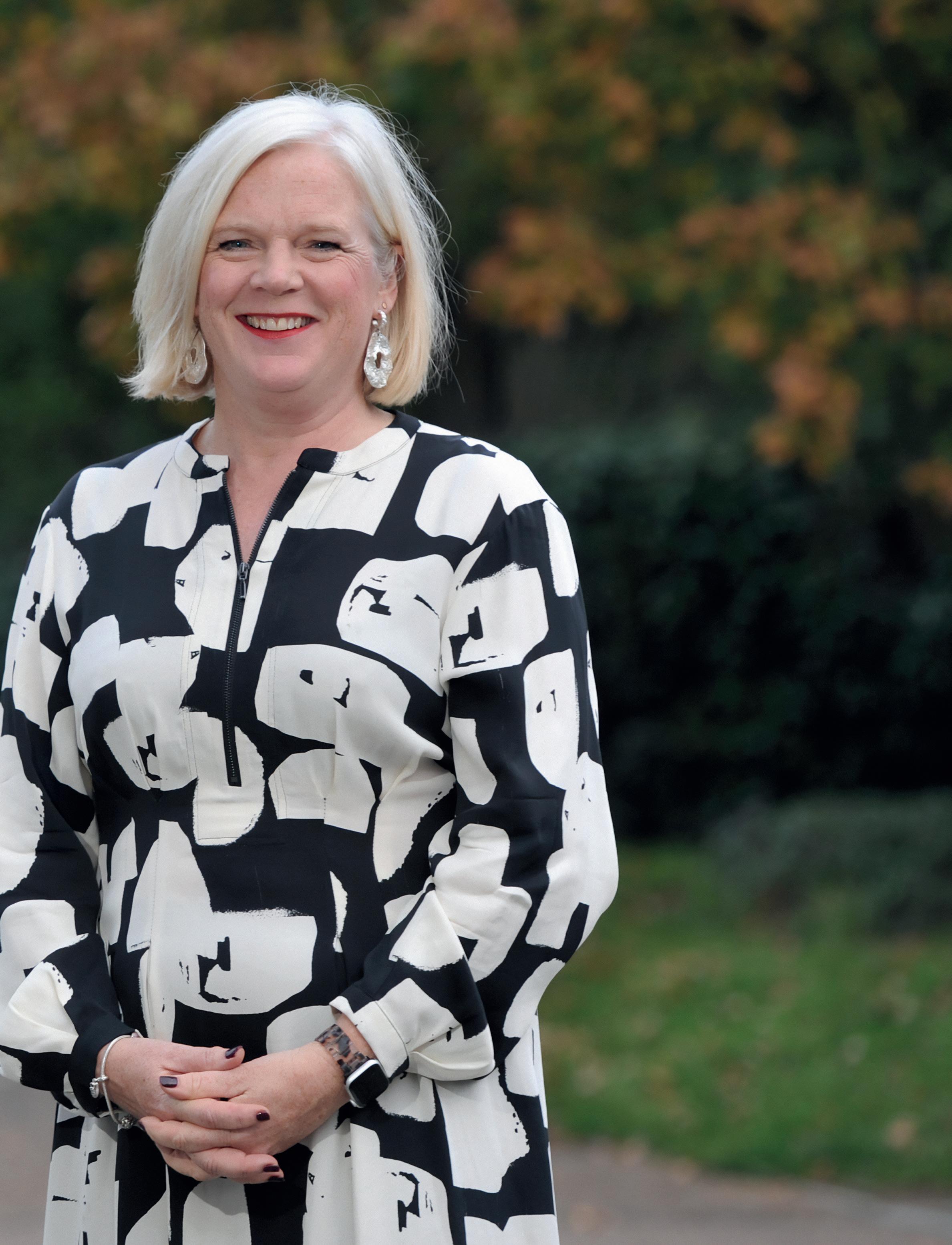
“When I joined, the university already had a strategy, although it’s too long. So while we have the essential building blocks, there wasn’t a golden thread running through the whole organisation”
“We needed to ask ourselves, who are we and what are we offering, and from the surveys we undertook in my first few months, we developed the idea of a connected university.
“If a student comes here, we want them to feel connected to place and to the outcomes that we are striving with them to deliver.”
She then turned her attention to the university’s course offer. “Business and computing are really important to us, but we are underperforming in the latter, so we are tidying up our course structures to focus on what students and industry are asking for.”
And while the university runs highly successful degrees in subjects such as journalism and photography, the portfolio of courses in other arts and creative subjects has been narrowed because it’s not attracting the student numbers to make it viable.
However, numbers on health and social care degree courses are strong at the university, nursing currently less so as demand for places has dropped since Covid.
Historically universities have often added courses without cancelling others to chase student numbers, but Clare sees that uneconomic.
Updating a university’s course offer means adapting its physical building and campus requirements.
In 2021, the university took a huge gamble and bought the former Debenhams department store in Gloucester.
It was a brave (and costly) commitment to take on and refurbish such a prominent 1930s listed Art Deco building, but it garnered a lot of local government support and national levelling up funding, because everyone can see the benefits of bringing thousands of students, their spending power and community, right into the heart of a city undergoing major regeneration.
The project was already running late when Clare arrived at the university, but she is determined to see it through. “Fundamentally it will be fantastic for Gloucester when it opens next summer and while there are challenges, we are overcoming them. It will be wonderful to open the doors on a major new campus for students alongside a new home for the city’s library and other community activities.”
Alongside this major project the university is rationalising other parts of its estate, including selling off pockets of land such as its Hardwick Campus in Cheltenham, while its Park Campus in the town will become the university’s centre for creative and computing subjects.
To date, Clare’s tenure at the university has been all about embracing the necessary change that all universities are facing and making sure she talks with staff and students regularly.
“We are sharing what the future looks like and what there is to be optimistic about. For our students, it’s about their careers and the start of their life journey. And to achieve that you need the right team and the right leadership in place – and you need to keep a close eye on the money.”
The University of Gloucestershire isn’t alone of course. Last year, Universities UK, a collective voice of 141 universities, published a new report which it refers to as a ‘blueprint for change’.
We want consistency and teaching excellence across all our courses, and that’s what I’m striving for
The blueprint calls on the government to stabilise the sector’s finances and increase direct public funding in England so the cost of going to university is rebalanced towards government instead of students.
Clare fully endorses three key ideas within the report: undertaking a major efficiency drive by every university, widening participation and working more closely with local businesses – embracing the partnership approach about which she is most passionate.
After graduating with a degree in History and Politics from the University of Hull, Clare considered a career in politics, but instead took a graduate job at Rank Hovis McDougall.
“I was a production management trainee in cakes and bread. It was male dominated and that quickly toughened me up.”
She spent four years at the company before moving to management consultancy Deloitte. “Whatever my next career move was, I decided it definitely wouldn’t be visiting a food production line and wearing hair nets every day.”
At Deloitte, her clients included Burberry, the Midlands Electricity Board and Abbey National Bank – so absolutely no hairnets required.
From there she moved into government contracts for Deloitte, heading up one of the early NHS IT programmes.
Marriage and parenthood followed, but putting her baby in a Leeds nursery before travelling around the UK for work was not the family life she wanted.
Her next career move, therefore, was into local government, as Head of Change at Worcestershire County Council.
While she reduced her travelling, what she hadn’t realised was quite how much her workload would increase.
“This was it in 2010, a tumultuous period for local government. It was the time of austerity, David Cameron and George Osborne’s big society aspirations.
“But I absolutely loved my three years in the role, and being able to make a difference in local government.”
When Worcestershire County Council’s Chief Executive decided to retire in 2014, Clare was appointed.
“Working in local government is gruelling, but I loved it and those in the sector have got a huge amount of resilience.”
Every industry she’s worked in over her career has seen huge change, which is why for Clare, everything goes back to the people.
“As Chief Executive of UCAS, and during my time at Worcestershire County Council, I got a clear idea of what good leadership looks like.
“In a world full of uncertainty, none of us truly know what’s going to happen in the future. But what I can do as a leader is to say that we will all go through this together, and I will learn as much from my team as I hope they do from me.”
Where does she see the University of Gloucestershire in a few years’ time?
“We will have a smaller physical footprint, but a bigger virtual footprint. We want to have more impact regionally, not just in terms of student recruitment but also in business and economic impact.
“We want to increase student numbers to more than 10,000 and our prospectus to truly represent what businesses are looking for. I want us to go from strength to strength in the apprenticeship space and to widen the concept of lifelong learning, offering more short courses which can be built up into a full degree, if that’s what our students want.”


The Lucky Onion Group, owned by Superdry founder Julian Dunkerton, has been embroiled in a battle with Cheltenham Borough Council for months over the huge marquees outside his hotel, restaurant and bar at 131 The Prom.
The council doesn’t like them but The Lucky Onion says it needs them for a viable business.
Now Julian has come up with a bold new idea. He is proposing a new terrace which will offer either a glass structure with decorative ironwork, or a slim metal pergola with retractable roof.
The marquees in contention were put up to accommodate social distancing during Covid-19, but when the pandemic ended, the Borough Council adamantly refused permission for them to remain, a decision supported by the civic society – and some businesses, which argued that the hotel was claiming a commercial advantage with marquees denied to them and others.
The Lucky Onion says that both new options complement the Regency architecture, designed with award-winning local architects and heritage experts. No 131 has engaged with Cheltenham Borough Council, and separately, with Historic England, through the preapplication process.
But while Julian says the proposed terrace will enhance the iconic appeal

of No 131 and cement its status as a top UK hospitality venue, Cheltenham’s civic society still isn’t happy.
In a submission to the planning application, it said: “To allow this proposal would do huge damage to the setting and appearance of three exceptionally fine buildings.”
Over the years, Julian has invested millions of pounds into the town and surrounding area. Julian and his wife, the clothing designer Jade Holland Cooper, have invested in venues employing hundreds of people. His recent reinvention of Dowdeswell Park near Charlton Kings has turned a tired nine-acre industrial estate into a bustling and attractive food and retail destination, which is also home to his eponymous cider company, Dunkerton's Cider.
Julian said: "The importance of seeking approval for our proposal should not be underestimated. It saves around 100
jobs for local people and enables us to create something unique and distinctive for the town. Making the terrace of 131 a permanent feature ensures the venue itself is economically viable and allows us to plan for the future, bringing more investment into Cheltenham.”
Tourism generates around £162 million in annual visitor spending, with the hospitality sector directly supporting around 8,550 jobs in accommodation, food, the arts and entertainment.
In its submission to Cheltenham’s planning team, The Lucky Onion representatives said: “Finances show the year-round capacity of the covered terrace space generates more than 50 per cent of 131's revenues from dining and drinking. Removing this would necessitate making 62 staff immediately redundant, a 61 per cent reduction – and threaten the jobs of all those (more than 100) employed at the property due to the risk to its viability overall.
Gloucestershire’s three university vicechancellors have vowed to work more closely together.
The UK’s university sector is facing continued financial challenges, and the Office for Students has revealed continued pressures on the sector as the number of students entering higher education falls.
The vice-chancellors of the University of Gloucestershire, the Royal Agricultural University and Hartpury University and College have therefore agreed to collaborate to promote the county’s tertiary offer as a whole.
At a meeting convened by Ian Mean, director at Business West, and attended by John Wilkinson, director at the Western Gateway pan-regional partnership, vice-chancellors Clare Marchant DBE (the University of Gloucestershire), Peter McCaffery (Royal Agricultural University) and Andy Collop (Hartpury University and College) welcomed the opportunity to work more closely together to promote Gloucestershire as a centre for higher educational learning and development.
Clare Marchant said: “The south west is the second lowest in terms of progression into higher education and there is a huge opportunity for us to work collectively to improve that.
“We have already begun to do this internationally, but there is a great opportunity to showcase the benefits of studying at one of our three Gloucestershire universities to young people across the UK.”
The collaboration model which the Gloucestershire universities would like to follow is that of GW4, the alliance of four research-intensive universities across the wider south west – Bristol, Bath, Exeter and Cardiff, which was founded in 2013.
John Wilkinson said: “There is a big opportunity for all the Western Gateway universities to come together. Collectively positioning the region in the student recruitment market will undoubtedly help drive up awareness of what the region’s higher education sector has to offer.”
Last summer Business West launched a new foundation for sustainable and inclusive economic growth. Called Futures West, it’s a collaboration between business and the region’s leading universities. It will
commission research to inform national policy makers and attract inward investment.
John said: “Business and universities share a common goal: they’re key anchors in their communities and are able to think long-term.
“Universities are also generators of new ideas and intellectual property in a very competitive world.”
One difficulty for Gloucestershire is that, as a largely rural county, it is not as visible to the government as larger urban conurbations such as Bristol and Bath, despite the region being the largest growing economic area of the UK.
Andy Collop, at Hartpury University and College, agreed with the collective approach.
“As a college and a university, our heritage goes back to just after World War II when Hartpury was established to train the next generation of farmers. We have grown to provide high quality training and education across a wider range of agriculture, animal, business, equine, sports and vet nursing degrees and qualifications, but the one thing that roots us in our community is a sense of place.
“So the civic agenda is really important to us, as are our partnerships with businesses across the region.”
Peter McCaffery at the Royal Agricultural University agreed. “Both us and Hartpury operate in the agricultural sector but most of what we offer is complementary, not competitive.”
Business West director, Ian Mean, said: “All three university chancellors in Gloucestershire are relatively new in their post.
“This presents a golden opportunity for them to promote Gloucestershire collectively at university recruitment fairs and to the government at regional and national level.
“Gloucestershire has strengths in many areas, particularly in food and agriculture, cyber and technology.
“Collective promotion of these will raise the county’s profile nationally, attract more young people into the county to study and encourage them to build successful careers here.”

Gloucester-headquartered kitchenware firm ProCook reported strong trading in its second quarter for the 16 weeks to October 13 and revealed it planned to open 10 new stores this year, including in Guildford, Exeter and Bournemouth.
Four (Bracknell, Birmingham, Newcastle and Oxford) were opened in the first half of last year and the firm said it was committed to opening a further six.
Chief Executive Lee Tappenden said: "We have continued to build on recent momentum and outperform the market, with strong trading in the second quarter, as we made significant progress in accelerating profitable growth."
In the company’s second quarter, total revenue came in at £17 million – up more than eight per cent yearon-year.
Retail revenue increased by more than seven per cent while e-commerce revenue increased by more than 12 per cent reflecting a significantly improved performance on last year, the company said.


Do you padel? The UK’s fastest growing leisure sport is popping up everywhere.
Now Peel Retail & Leisure has opened a new padel club at Gloucester Quays Retail Park, bringing the leisure activity to an indoor centre in the city for the first time.
The Padel Club has invested £1 million in its new indoor venue at Gloucester Quays Retail Park, which includes nine courts.
Padel is an innovative form of tennis played in an enclosed space about a third the size of a typical court, and is, according to The Padel Club, the fastest growing sport in the world.
Mark Whittaker, Managing Director at Peel Retail & Leisure, said: “The popularity of padel has risen exponentially, and no doubt there will be plenty of people that live in, work in or visit Gloucester that love the sport. Operators like The Padel Club will have had lots of options in the region for opening a new venue, so we wanted to make sure this is something we could
The popularity of padel has risen exponentially, and no doubt there will be plenty of people that live in, work in or visit Gloucester that love the sport
bring to the city before anyone else.”
Hannah Thomas, General Manager at The Padel Club Gloucester Quays, added: “Padel has taken off in the UK because it’s more than just a sport or a fun way to exercise, it also brings a real sense of community and is one of the most accessible activities around.”
The new padel offering is part of a wider £14 million regeneration scheme at Gloucester Quays Retail Park.
Construction has begun on a new Next store. The glass-fronted building will be one of Next’s new-look ‘dual-format’ stores, the first in the South West of England, providing a total floor area of 45,371 sq ft over three floors including an in-store café.
Improvement works are also set to be carried out on the remainder of the retail park’s cladding and signage to bring it in line with the new Iceland and Home Bargains frontage.

One of England’s oldest vineyards has gone up for sale with a price tag of more than £2 million.
Planted in 1971, Astley Vineyard is a single estate vineyard. It is one of the oldest vineyards in the UK, located in the beautiful Severn Valley.
The vineyard was bought by the
Haywood family in 2017. They purchased it from the Daniels family who ran it from the early 1990s. The vineyard now produces around 6,000 bottles of wine a year.
The estate includes five acres of planted vines across a total of more than 8.5 acres, two houses, a visitors’ centre, shepherds huts and woodland.
First deal on newly refurbished Redditch industrial scheme confirmed
An 11,800 sq ft refurbished warehouse at Lakeside Industrial Estate in Redditch has been let to Trinity Claims on a five-year lease with a new headline rent achieved.
Neil Slade, Director at Harris Lamb who is overseeing the marketing of the scheme, said: “With demand for quality industrial property continuing to outstrip supply, owners Logicor have committed to an extensive investment in overhauling the properties to provide good quality space in the Redditch area.
“Lakeside has always been a highly sought-after location and there is little availability within the area. Having secured insurance claims management specialist Trinity Claims as the latest new tenant, there is significant interest in other opportunities at this site.
“With the undersupply in Solihull, Redditch is proving a popular overspill location given its excellent access to the UK motorway network via the M42.”
A trailblazing Midlands entrepreneur has landed a global accolade for his leadership.
David Ogden, founder of The Key Safe Company in Worcester, has been named Most Innovative Key Security Solutions CEO (UK) in the Global CEO Excellence Awards 2024.
The awards recognise leaders who have steered their organisations towards growth, innovation and success against the backdrop of an ever-changing business environment.
David said: “To be nominated for such a prestigious award was an honour. To win it, ahead of incredibly bright and talented peers in the sector, feels like a really big achievement.”
The Key Safe Company designs and manufactures key safes and other access management products, and Birmingham-born David has sold more than two million key safes worldwide since launching the business in 1996.
He said: “Everyone at the company is invested in what we do and why we do it. Many employees have worked here for a long time, including our wonderful Chief of Staff Natalie Ward, who recently celebrated her 26th work anniversary.
“That longevity speaks volumes for the culture we have created and this is paying off in all areas of the business, from product design and quality control to customer service and after-sales care.”


A manufacturer of technical and protective performance apparel has moved its headquarters to Worcester as it aims to triple operational capacity.
Pulsar has relocated to a 45,000 sq ft facility at Indurent Park, Broomhall.
Stuart Jukes, managing director at Pulsar, said: “The relocation and upsize of our headquarters marks the next stage of growth for Pulsar and strengthens our journey of pushing innovation boundaries in hi-visibility clothing and highperformance safety garments.
“We required a strategic location that combined size. The warehouse facility will enhance our operational capabilities threefold and emphasise our commitment to fostering long-term business growth.
“Our new multi-functional workspace also protects our core values as a family-owned business.
“We’ve found a home that caters to the needs of our modern workforce and the environment. The scenic views of the Malvern Hills from our boardroom is just the icing on the cake.”

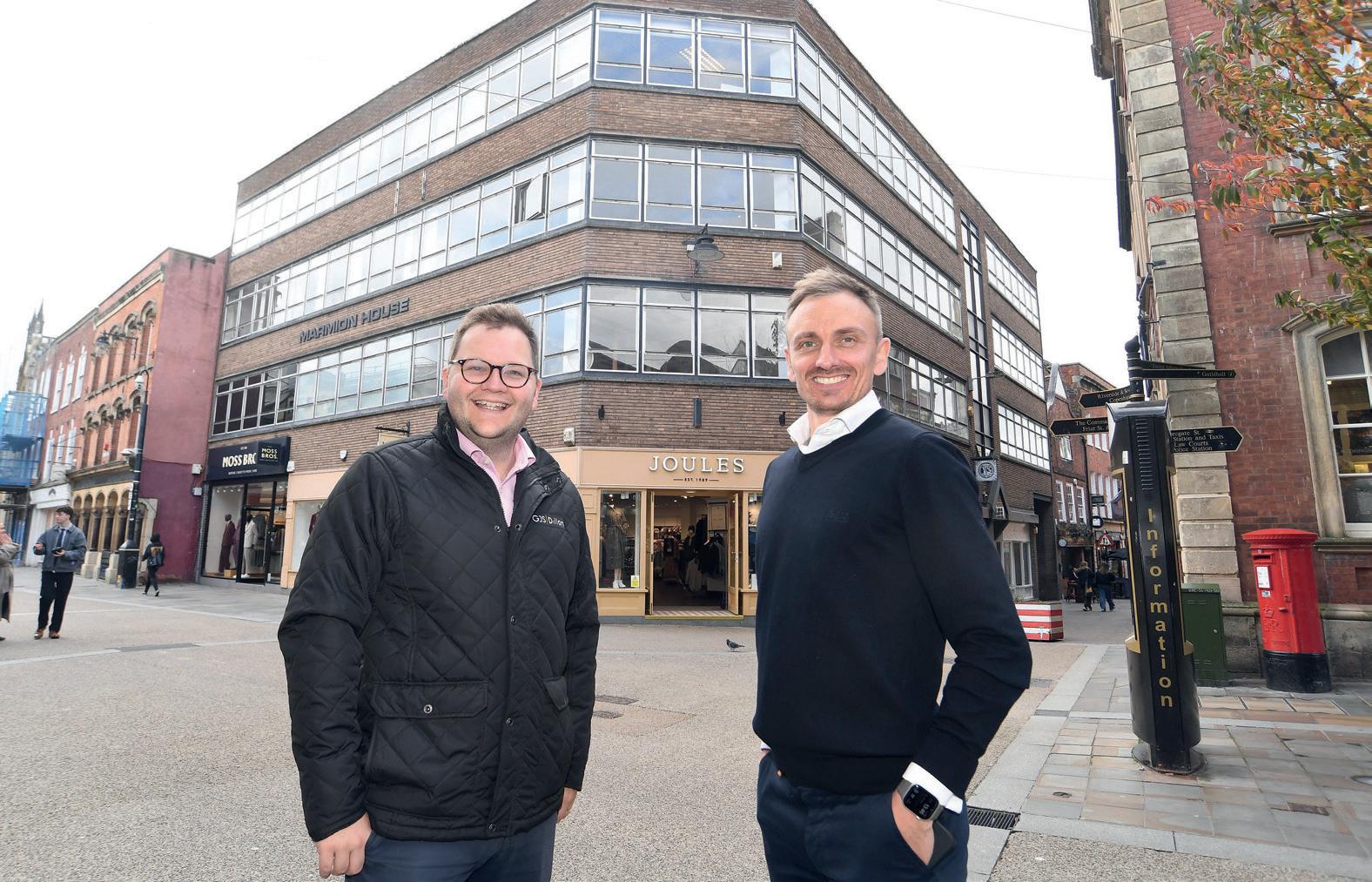
Marmion House, in the centre of Worcester, is poised to get a makeover after Midlands property firm EDG bought the building.
Located on the corner of High Street and Copenhagen Street, its High Street frontage is already home to Joules and Moss Bros, while Keystones Cocktail Bar is in Copenhagen Street.
The upper three floors are offices, let to tenants, including GMP Recruitment, Big Helping and Boulevard.
EDG will refurbish the three remaining vacant office suites before bringing them
to market through appointed letting agents GJS Dillon.
EDG also has plans to significantly improve several areas of the building, with investment in the entrance space, reception area, communal spaces and amenity zones.
Neil Edginton, director of EDG Property, said: “The building is already home to some highly regarded tenants.”
The property adds to EDG’s growing investment portfolio, which includes recent acquisitions in Coventry, Weymouth and Dorchester.
A prominent, 66,000 sq ft industrial warehouse on Worcester Road in Kidderminster is up for let again after NEOS Superform vacated the premises in November having gone into administration.
The building was previously occupied by Sealine, a company which manufactured luxury boats (rather incongruously for those of us who regularly drove past the facility which is hundreds of miles away from the nearest sea).
Sealine moved out in 2013, after the brand was sold to HanseYachts AG.
Charles D’Auncey, Director at agents Harris Lamb, which is marketing the property said: “Industrial opportunities of this calibre and scale are unusual in Kidderminster.
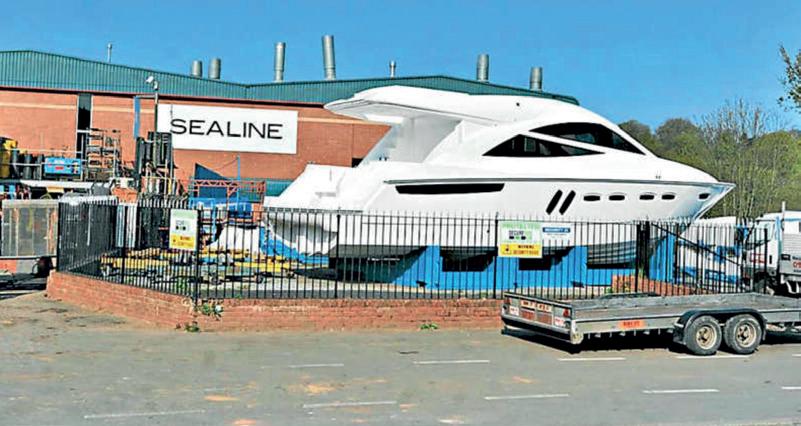

“With a nine-metre eaves height, loading doors to front and rear, a large power supply and full length craneage up to 20 tonnes, the building is well-equipped and securely fenced with tarmac and concrete loading areas.
“It is a prime Worcestershire opportunity in a prominent location and with supply being limited, we are anticipating good levels of demand.”

Avon Technologies, the Melksham manufacturer of military helmets, gas masks and respiratory protection for fire, military and law enforcement, closed the year with a record $225.2 million order book, a more than 64 per cent increase on last year.
This strong order intake was predominantly driven by growth in its Team Wendy next generation head protection system and second-generation advanced combat helmet orders from the US Department of Defence and accessory sales.
Avon Protection also doubled its orders from the UK's Ministry of Defence alongside the US Department of Defence and orders from Australia, Germany and New Zealand.
Jos Sclater, Chief Executive Officer, said: "I am excited by the ability of the organisation to change and translate strategy into action.
“We have built a culture where improving processes is becoming the Avon way of life, we have much more capable people and the pace of change is accelerating.
"As a result of our progress during the year, we see the potential to reach our operating margin and return on invested
capital guidance target ranges a year early, in 2026.
"We also expect our transformation programme to be largely complete by then, with an accompanying significant decrease in transformation cash costs providing the platform for a broader capital allocation strategy.”
The current geopolitical situation continues to support demand for masks and helmets.
Avon Protection is seeing evidence of higher numbers of on-the-ground personnel, higher personal equipment specifications and a rise in perceived threat levels including chemical, biological, radiological and nuclear attacks.
This, along with continued equipment modernisation programmes, is boosting budget requests within NATO countries.
In the US first-responder market, the prevalence of guns and drugs supports demand for ballistic helmets and respiratory protection.
The company is also seeing the USA's West Coast police forces re-capitalising in preparation for the FIFA World Cup in 2026 and the Los Angeles Olympics in 2028.
The redevelopment of land around Swindon train station will be one of the UK’s largest brownfield regeneration projects if it gets the go-ahead.
The newly-formed Swindon Railway Quarter Redevelopment Board is looking at how the land could be repurposed to provide a new commercial, educational and residential quarter, while keeping essential car parking next to the station.
UKRI, the public body sponsored by the Department for Science, Innovation and Technology (DSIT), is headquartered next to the station. Also located close by is iCAST, a joint venture between the Universities of Oxford and Bath.
Professor Dame Ottoline Leyser, Chief Executive of UK Research and Innovation (UKRI) said “UKRI is proud to be headquartered in Swindon and excited about the plans for Swindon Knowledge Central. Collaboration is essential to drive excellence in research and innovation.
“This project offers the opportunity to bring innovative companies and public sector organisations together in high-quality spaces to create a thriving community, connected both locally and nationally.”
Cllr Jim Robbins, Leader of Swindon Borough Council said: “The Board is determined to seize this huge opportunity to transform the area around Swindon station which has the potential to create new high quality jobs and homes within the heart of Swindon.
“There is real momentum after the completion of the first phase which saw the council’s co-investment with the Universities of Oxford and Bath in a new national R&D centre in green technologies at the Carriage Works.”


Siemens Mobility has secured planning permission for a £100 million manufacturing, digital engineering and R&D centre at SouthPoint Business Park in Chippenham.
It will replace its existing facility at Langley Park, where it will build the next generation of conventional and digital rail signalling and control systems for Britain.
Siemens employs around 800 people in


Chippenham, where the company has been based for more than 100 years.
The permission is for a bespoke manufacturing, digital engineering and research and development centre, including production facilities, rail signalling R&D, an external area for static testing of signalling equipment, digital integration and testing facilities, warehouse and operation facilities, ancillary office space and staff facilities.
The company said the permission will secure the long-term future of Siemens Mobility in Chippenham, retaining jobs with the potential for future employment opportunities, and paving the way for future investment from other associated companies in the local area.
Construction is expected to begin shortly and be completed in 2026.
Island Green Power, the developer putting forward proposals for Lime Down Solar Park near Malmesbury has published its stage one community consultation.
The report outlines the key themes from feedback received on the proposed project.
When built, the solar park could deliver up to 500MW of renewable energy. This is equivalent to providing enough clean, affordable electricity to power approximately 115,000 homes annually.
Established in 2013, Island Green Power builds renewable energy projects. It specialises in developing utility-scale solar projects and battery energy storage systems.
Over the last decade it has built more than 34 projects worldwide totalling more than one gigawatt of renewable
energy assets. This includes 17 projects in the UK and Republic of Ireland.
But it has seen considerable opposition from Wiltshire residents, who say that if it goes ahead, the solar park will stretch across 2,000 acres of farmland to the north of the M4, south west of Malmesbury.
Will Threlfall, Senior Project Development Manager for Lime Down Solar Park, said: “We thank everyone who has given feedback to the Lime Down Solar Park team during our stage one consultation.
“It has been invaluable to hear directly from the local community on our proposals including what must be prioritised in our designs. We now have a better understanding of what is important from a landscape, nature, and community perspective that will be addressed as we refine our plans.”
Last year Sir Michael Pitt, who was the Chief Executive of the Planning Inspectorate between March 2011 and June 2014, spoke on behalf of the Stop Lime Down campaigning group. He said: ““We believe the Lime Down Solar Farm development is the most damaging assault on the county’s landscape in more than a lifetime. To call it a farm is an aberration. It is a vast industrial complex with battery storage, transformers and ugly solar cells some 4.5 metres high.”
The government doesn’t know how much land is used for solar farms, because its renewable energy planning database does not record the total area of each solar farm. However it says that there are more than 1,330 operational solar farms across the country. More than 140 are under construction, 1,957 are awaiting construction and a further 684 have submitted applications.
An Italian multi-national company which makes products for diagnostic imaging has chosen Warwick for its UK testing and repairs site after moving the service in-house.
The UK arm of Bracco, based in Oxford, has a strong sales presence in this country with products used in the NHS and private hospitals, but relied on third parties to repair equipment and test new products.
This has changed as the firm signed a lease on a warehouse and offices at Titan Business Centre in Warwick after Leamington-based agents Wareing & Company secured a deal.
The company produces such things as the chemicals that can be detected in X-rays, MRI scans, along with devices that can administer them.

“The warehouse will enable us to kick-start our in-house repair and testing service...”


Coventry-based Arden Fine Foods, a leading sourcer and supplier of biscuits and bakery products, has been acquired by its management team, led by Managing Director Helen Young and Finance Director Andy Mewis. The deal value was not disclosed.
Arden, which has a turnover of more than £20 million, works with food manufacturers globally to develop sweet and savoury biscuits and other seasonal products which are then supplied into multiple retailers and through many other channels. Arden
Mark Pittaway, service manager for Bracco UK, said: "The warehouse will enable us to kick-start our in-house repair and testing service in the UK, which will significantly improve our customers’ experience."
provides products across private label, supplier brand and via its own Arden brand.
Helen Young said: “My team and I are very pleased to have completed this transaction and look forward to the next phase of development for Arden.
Significant opportunity now exists to build on the business’s history and reputation within the industry.”
Corporate finance company
Springboard advised Arden on the deal, the second management buy-out it has advised on at Arden in the last five years.
The transaction was completed with funding from Barclays Corporate Team. The current shareholders of Arden retain a significant financial interest in the business. The deal represents an exit for Arden Executive Chairman Gary Barr.
The husband and wife owners of a south Warwickshire cidery which began life in their back garden 10 years ago, are celebrating a lucrative new deal with Ocado.
The signature range of drinks from Jolyon and Charlotte Olivier’s Napton Cidery can now be bought through the giant online grocery retailer which delivers to 80 per cent of the UK population.
The brand has also just been accepted on the inaugural Ocado Roots Programme, developed to showcase 100 new ‘challenger brands’ within the retailer’s range. This is available to small suppliers which are not yet listed with other major supermarkets.
It offers bespoke onboarding and training, faster payment terms, support from a dedicated Ocado Roots team and support network and free data from Ocado’s insights tool.
Jolyon Olivier said: “When we began making cider from the apple tree in our back garden 10 years ago, we never imagined we would have it sold on Ocado.


“We’ve managed to go from pressing 2,000 litres in 2015 to producing more than 250,000 pints per year.”
The team now produces cider from six orchards across the Herefordshire region. They also produce barrel aged limitededition ciders as well as gold medalwinning perry, apple brandy and vinegars.

We’ve
managed to go from pressing 2,000 litres in 2015 to producing more than 250,000 pints per year


More than 100 jobs have been saved after Coventry-based Evtec Fab acquired Swindon manufacturer Retrac Group.
Retrac, which manufactures carbon fibre products, chassis and complex components for brands in the automotive, aerospace, Formula One and motorsport sectors, entered administration in October.
The business and assets were bought by Evtec Fab, itself part of the larger Midlands-based Evtec Group, which specialises in aluminium castings and assemblies for the automotive industry.
Acting for Evtec Fab, law firm Shakespeare Martineau provided restructuring, property, commercial, employment, corporate and tax services as part of the transaction.
Andy Taylor, partner and head of restructuring at Shakespeare Martineau, said: “We are absolutely thrilled to have been involved in an important transaction that has safeguarded the livelihoods of more than 100 talented people. The deal also expands Evtec Fab’s portfolio, adding Retrac’s expertise in component manufacturing to the group’s skillset.”
It’s not your typical charity dinner, but last year it raised more than £117,000 for local charities.
The Anti Banquet sees CEOs and business leaders swap their suits for aprons, working in the kitchen alongside Bristol chefs.
And it is set to return to Bristol’s Ashton Gate Stadium on March 27 after the overwhelming success of its inaugural event which highlighted the iniquities of food insecurity.
The first Anti Banquet’s charitable efforts directly funded 21 local causes through the Bristol Local Food Fund, with recipients including Black Mothers Matter, Travelling Kitchen and Project Mama. The donations provided resources for cooking education and support to low-income families.
Last year the event attracted more than 60 supporting companies, 50 volunteers and 25 chefs, including Michelin-starred chefs like Peter Sanchez-Iglesias and Jude Kereama cooking alongside business leaders.
This year the event aims to raise another £100,000.
Guests can expect culinary brilliance from Michelin-starred Josh Eggleton of The Pony & Trap and Ben Harvey, chef and director of Bianchi's Group.
Attendees, including emergency service personnel, charity workers and those who rarely experience fine dining, will enjoy gourmet food and entertainment hosted by Bristol comedian and opera singer Jayde Adams and actor Joe Sims.




Each table donates funds to support crucial food projects.
“We're calling on Bristol’s business community to step up, not just to enjoy a great evening, but to make a real difference,” said Josh Eggleton, co-founder of the event.
“Every pound raised supports local families, helping to ensure no one in our city has to go hungry”.


athlete conditioning programmes.
According to co-founder and CEO, Ben Wilkins, the pioneering technology enables users to analyse and evaluate aquatic rehabilitation accurately for the first time.
Good Boost has won national and international awards, alongside being highlighted as best practice in NHS, government and industry reports.






Bristol start-up, Good Boost, has secured a £150,000 investment from the British Design Fund as part of a £500,000 funding round to accelerate the development of its AI-driven, aquatic rehabilitation technology.
Good Boost is aiming to transform swimming pools and community spaces into places to support rehabilitation and healthy ageing.
The company’s digital aqua paddles make it possible to quantify human movement in water. It says this aids patient recovery and
20 million people in the UK
Ben explains: “Pain and joint conditions, collectively known as musculoskeletal conditions, affect 20 million people in the UK and 1.7 billion people globally. Many of these disorders can be effectively treated and managed through water-based therapeutic interventions.
“However, until now, we have been unable to measure movement in water to assess the power, speed or range of movement with any accuracy. Good Boost has cracked that engineering challenge.”
He continued: “On the sports side, injuries account for 60 per cent of player absences. Our technology can provide analysis and feedback as part of an athlete’s aquatic recovery programme.”
The latest funding round will support the company’s work within public swimming pools, leisure centres and gyms, as well as deployment into more specialist hydrotherapy pools and athlete recovery training pools. It will also be used for further research and development.
Damon Bonser, CEO, British Design Fund, said: “Spotting and understanding a problem and being led by end users to engineer an effective solution is at the heart of Good Boost’s technology.
“The team are all experts in their field and the innovative technology they have developed has significant potential to support rehabilitation on a global scale.”
British Design Fund is a leading early-stage British manufacturing investor. The Fund works with ambitious product start-up enterprises ready to scale-up.
Tech4Good South West has revealed its inaugural cohort of champions, recognising individuals based across the South West using technology to drive positive change and generate social impact
“These champions represent the very best of how technology can be harnessed for social good,” said Annie Legge, founder of Tech4Good South West.

Richard Wheatley, co-founder HeadX: Richard is developing a wearable device to help manage sports-related concussions. He’s also worked with Bristol-based DEEP, the company building a modular vessel for underwater exploration. He is an active mentor with the Institute of Engineering & Technology and a trustee for Crossroads Care Gloucestershire looking at how technology can enhance social care services. He has more than 20 years’ experience improving processes in engineering and IT.
John Bradford, Digilocal: DigiLocal was formed following a skills and diversity event. Working with the Bristol Somali Resource Centre and other community partners, it aims to improve access to coding skills for young people. Launched in 2015, DigiLocal has supported more than 200 volunteers and 3,000 young people through weekly coding clubs in community venues across Bristol. Participants have gone on to study computer science and many return as volunteers inspiring the next generation. Digilocal is also the NASA Space Apps Challenge Lead for Bristol.
“What they all have in common is passion, creativity and a commitment to making a difference in their communities. This is the first cohort of Tech4Good South West
Frazer Meakin, Pervasive Media
Studio: A former teacher, Frazer has completed a 10-month Fellowship in Residence with Bristol’s MyWorld project. He is using technology as a tool for good by empowering young people to pursue careers in creative technologies. He has engaged with more than 700 young people through the project, including 100 from special educational needs provision schools and 25 from Alternative Learning Provisions.


Champions who have been chosen by a panel of experts and peers.
We’re honoured to shine a light on their incredible work.”

John Stienlet and Sabita Ravi, Quartet Community Foundation: As a regional funding organisation Quartet has been championing the power of local philanthropy for 37 years investing in £1.7 million in grants with a tech element in the last five years. Projects have included supporting 100 children to make their own podcasts; capacity-building grants to improve digital infrastructure and start-up grants.

The
world’s seabeds have been a mystery for millennia, but with the fast growth of off-shore wind turbines, we need to know what’s down there to anchor the thousands of wind turbines being built
By Nicky Godding, editor
Why do so much of our oceans remain unexplored?
Neil Armstrong set foot on the moon in 1969. Last year, a Chinese lunar probe landed on the dark side (alhough it took them more than 50 years after Pink Floyd sang about it).
We’ve successfully sent a small vehicle 140 million miles to Mars to collect soil samples – but what happens on more than 80 per cent of our ocean bed remains a mystery.
Why? Because below around 1,000 metres there is zero visibility, it’s extremely cold and the intense pressures in the ocean make it a truly hostile environment.
For millennia, this didn’t matter because all humankind did was bob around on the surface in ships.
That all changed in the mid-20th century when we began building oil wells.

Fast forward about 50 years and mankind is putting the oceans to economic use again, constructing off-shore wind turbines to support the global energy transition.
But that needs highly qualified and experienced geotechnical engineers to analyse the structure of the seabed – wind turbines have to withstand huge forces to stay upright and operational.
That’s where the expertise of Bristol-based offshore geotechnical company Geoquip Marine comes in.
The company provides offshore geotechnical site investigation services to some of the world’s largest energy companies.
And demand for its services is growing. Last year it began a £2 million investment

programme, which has included building a new laboratory in Bristol and furnishing it with state-of-the-art soil analysis equipment.
More recently, the company announced a four-year collaboration with the University of Bristol focusing on advanced experimental geotechnics research and skills development.
This new collaboration aims to address some of today’s pressing challenges in offshore geotechnical engineering, which are linked to global net-zero commitments.
It also aims to nurture talent and encourage interdisciplinary knowledge transfer to help improve understanding of offshore geotechnical engineering among academics and professionals. The university and Geoquip will combine some research activities. Geoquip is also contributing towards new advanced testing equipment at the university’s geomechanics laboratory.
“There’s a lack of companies around the world that can undertake the skilled analysis we are now doing”

Chris Brandish-Lowe, Head of Engineering at Geoquip, said: “We know continuous improvement and innovation are vital for maintaining our company’s competitive edge. This new partnership with the university aligns well with our mission to provide high-quality engineering services on a global scale”.
The majority of Geoquip’s current business is soil analysis for companies building offshore wind farms.
“We have six geotechnical drilling rigs and a wide range of seabed equipment,” explained Chris. “The rigs visit the sites of proposed wind turbines all over the world. Our team drill samples from the ocean floor and send them back to our facility here in Bristol for detailed analysis.”
Geoquip Marine’s soil analysis provides the essential information its clients need to plan and build the foundations for wind turbines.
Except for Antarctica, the company has
carried out projects across all the world’s continents.
The Geoquip Marine Group was established in 2011 by chartered engineer Andrew Wright, who has decades of experience in consultancy and construction in Europe and the Middle East.
In 2014, Geoquip secured investment from Njord Partners, a specialist European investment fund. Four years later, Njord made a further major investment in Geoquip, which had enjoyed a recordbreaking year in 2018 – the company had achieved a 100 per cent increase in turnover and 50 per cent increase in profit.
And the growth hasn’t stopped. Geoquip is currently generating record annual revenues of more than £100 million. It employs more than 150 people – most work at its head office in Bristol and in its new research facility on the edge of the city centre.
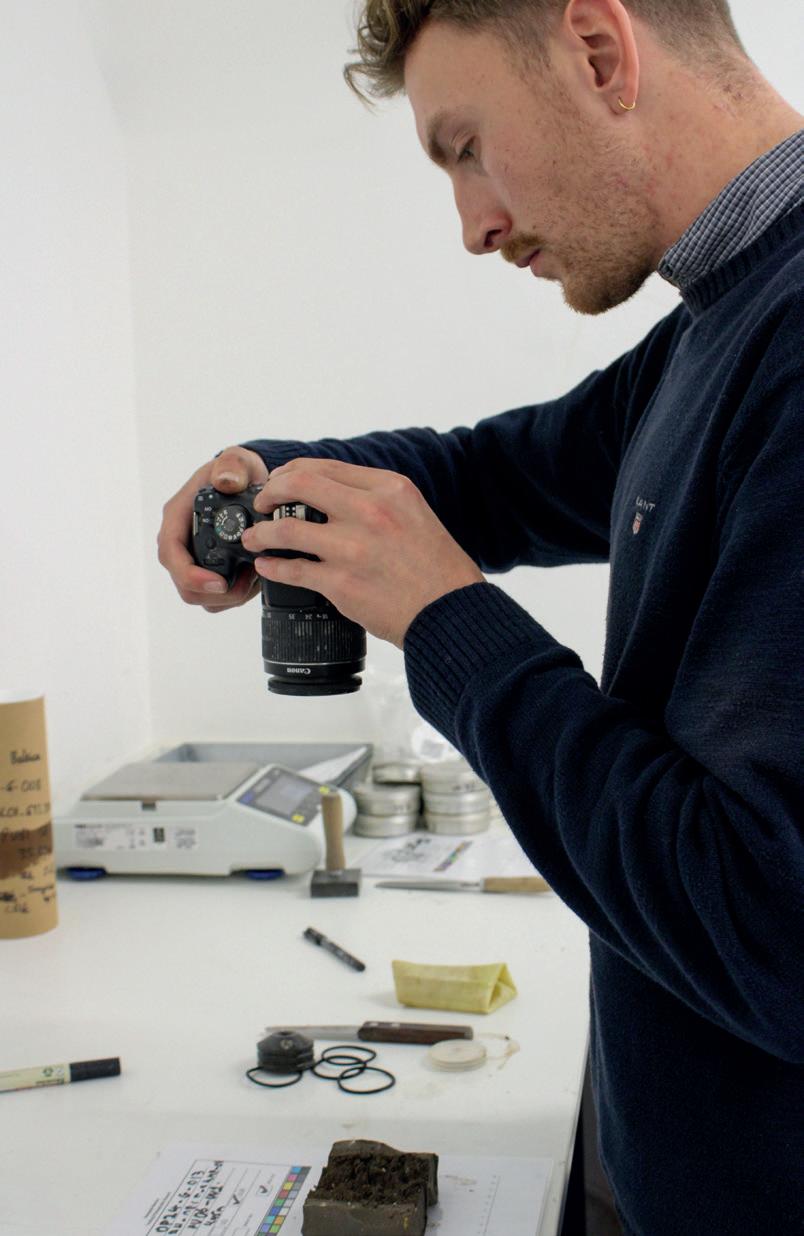

Last September, Geoquip appointed Rune Olav Pedersen as CEO. He had spent the last 14 years at PGS, the Oslo-listed marine geophysical company, and as CEO led its successful turnaround and merger with a Norwegian offshore energy services company.
There are around 2,695 offshore wind turbines in the UK, with a combined capacity of more than 14,000 megawatts. Offshore turbines are considered more efficient than onshore ones, thanks to the higher speed of winds, greater consistency and lack of physical interference from land or human-made objects.
They also have less environmental impact than onshore turbines and the government (and many others) want to build more of them. It wants to connect an extra 40GW of offshore wind to the electricity grid by 2030.
But they are also technically challenging
to build. While Britain’s first offshore wind farms have been built on the relatively shallow shelf around our coastline, Geoquip Marine is now testing soils from the deeper ocean bed, around the UK and much further afield.
Chris Brandish-Lowe explained: “The majority of our vessels can work in water depths as little as 12 metres, Fixed bottom turbines are typically around 30 metres, however beyond 50-60 metres the foundations being considered are floating which of course we have capability for.”
Floating wind turbines are built in areas where fixed-foundation turbines are not feasible.
While the UK’s shallower shelf can accommodate fixed-foundation turbines, Geoquip Marine is also working on analysis of ocean beds around the Mediterranean where the depth of the water is much greater (incidentally, Scotland also has a lot of deep water too).
Geoquip Marine’s clients are the energy companies, from BP to EDF and the Danish
multinational Ørsted, and many others.
While every Geoquip vessel has an onboard lab, soil samples are sent back to Bristol in specially sealed tubes, allowing them to arrive at the company’s research facility, via special couriers, in exactly the same condition as they came out of the ocean bed.
A full survey of an ocean bed can take a few days, or up to six months, depending on the complexity of the terrain and the customer requirement.
Along with soil analysis, the company also undertakes data management and can build 2D and 3D models to provide the best advice to customers.
Mingnan Li is Geoquip Marine’s Research and Development Engineer. He said: “Before our latest investment, we did use subcontracted labs. Now we can undertake a great deal more in-house.
“This has meant an increase in customer satisfaction, meeting deadlines and timelines.”
Geoquip Marine’s investment is strategic. “There’s a lack of companies around the world that can undertake the skilled analysis we are now doing,” adds Chris.
Currently the company has vessels in the Baltic, Mediterranean and United States. Most of its work continues to be in Europe, although Australia and Asia are opening up, as is the USA which has just 202 offshore wind farm projects – of which just three are currently operating, according to 4C Offshore marine intelligence.
Geoquip Marine considers that the biggest opportunity after the European Union is the Asia Pacific region.
Australia has recently opened up 12 leases, and South Korea, Japan, Taiwan and Vietnam all have announced offshore wind farm projects.
“The opportunities are huge,” says Chris. “Even with our recent expansion, I think we’re going to need a new regional office and more and bigger laboratories.”




In December this magazine was profoundly sad to hear that one of the country’s engineering greats had died
By Nicky Godding,
Editor
Sir David McMurtry, the man behind one of the UK’s most successful, yet too often under-the-radar engineering companies, has died.
Along with fellow Rolls-Royce engineer John Deer, Sir David co-founded Renishaw in 1973 to commercialise a 3D touch-trigger probe for co-ordinate measuring machines.
He had invented it to solve measurement problems faced in the manufacture of the Olympus engines that powered the mighty Concorde supersonic aircraft.
Sir David was a brilliant engineer who worked for Rolls-Royce in Bristol for 17 years. He became Deputy Chief Designer and its youngest ever Assistant Chief of Engine Design. He was responsible for 47 patents at Rolls-Royce and went on to be named on more than 200 patents for Renishaw innovations.
With Sir David at the helm, Renishaw revolutionised the development of co-

ordinate measuring machines, shopfloor metrology and process control, among many other innovations.
The company he co-founded now employs more than 5,000 people in 36 countries and reported record revenues of more than £691 million last September.
I met Sir David a number of times. While he was a private man who avoided publicity (difficult for his comms team), he was an absolute delight to interview face to face and despite building a global manufacturing business he was always an innovator and entrepreneur at heart.
Even when he stepped away from the dayto-day role of Chairman only last year, he still visited Renishaw – a small, slight man permanently fascinated with new ideas and approaches wherever they came from.
A few years ago, a campaign I co-founded called Rock the Cotswolds ran a major event called Innovation Rocks at Renishaw’s
Wotton-under-Edge headquarters in Gloucestershire to showcase the amazing companies based in the county.
We had a full house – mostly I think because all the innovators we had invited to pitch their ideas to investors were so keen to meet the legendary Sir David. Even in his 80s he retained his fascination with new ideas.
In 2016 he set up McMurtry Automotive with Thomas Yates, who moved from Mercedes where he was optimising Formula One power units for Lewis Hamilton and Nico Rosberg.
His enthusiasm for a completely new venture, even at then aged 76, was clear. He said: “Pushing boundaries using novel engineering has driven me throughout life. Applying this to my passion in the automotive sector and building cars that truly change what is possible on four wheels is a lifelong dream. The small and mighty team Thomas and I are growing in Gloucestershire will build a legacy for delivering world-class cars which perform beyond conventional expectations.”
The company, whose pure electric single-seater hypercar Spéirling is already breaking records, is based at Swinhay Farm, Wotton-under-Edge, where Sir David also commissioned the building of a futuristic home designed by architects Austin Design Works. While I understand the family never lived in it (media reports at the time said that his wife didn’t want to move), it is an exemplar for sustainable technology – and even formed the backdrop for some episodes of BBC’s Sherlock series.
Austin Design Works said the house remains a unique example of a modern country house and it is doubtful there will be others of this style, scale and ambition. Replace “country house” with “engineering genius” and it’s an appropriate description of Sir David himself.
According to the Sunday Times Rich List 2024, with an estimated net worth of £1.2 billion, Sir David McMurtry was the 135th richest person in the UK.
Gloucestershire and Great Britain has lost a truly great engineer, but the success of the business he co-founded with John Deer in 1973 is testament to his enduring legacy.
The Royal Academy of Engineering, in partnership with Amazon, has awarded Amazon Future Engineer Scholarships to 15 women students from low-income backgrounds studying engineering and computer science degrees in the UK.
This year’s recipients were recognised for their dedication to creating meaningful change through technology and will each receive a financial support package of up to £20,000. This year’s cohort includes Zoriana Aleyeva, a student who fled to Birmingham with her family following the outbreak of war in Ukraine. She has recently started a computer science degree at the University of Warwick. Grace Royle-Uwumagbe is studying computer systems engineering, also at the University of Warwick.
Gwendoline Sargent has also secured a scholarship. She is studying for an MEng in Mathematics and Computer Science at the University of Bristol.
Since the Amazon Future Engineers Scholarships were launched in 2021, to help address the under-representation of
women studying computer science and engineering at UK universities, more than £1.25 million worth of funding has been awarded and the programme currently supports 90 women studying STEM-related degrees at universities across the UK.
Lauren Kisser, Ambassador for Amazon Future Engineer & Director, Living Room Technology at Amazon, said: “Exceptional talent can be found right across the UK, but the tech sector risks a lack of diversity of thought if we don’t step up efforts to support students from diverse backgrounds into STEM subjects. At Amazon, we’re passionate about breaking down barriers to opportunity.”
Lynda Mann, Head of Education Programmes at the Royal Academy of Engineering, said: “Evidence suggests the Amazon Future Engineer Scholarships are having a real and positive impact on recipients, both in terms of their experience at university and their progression into careers in engineering and computing.”
Scholarship applications for the 2025-26 academic year will close on May 13.
Britain’s manufacturers are at risk of missing out on innovation and productivity gains due to a lack of confidence in digital technologies and AI, according to ‘Future Factories Powered by AI’ – published by Make UK, the manufacturers’ organisation.
The report examines the state of AI adoption in UK manufacturing, including the opportunities and challenges for manufacturers, and proposes how government initiatives and regulation can support the sector’s adoption of new technologies.
It finds that companies are using AI tools widely across their business, in particular for managing energy use and reducing waste, while three quarters of them plan to increase AI investment in the next year.
However, despite increased adoption, there remains a significant knowledge gap around
AI’s potential uses among businesses with only 16 per cent regarding themselves as knowledgeable on the subject.
As a result, only a third of companies are using AI specifically in their manufacturing operations. Robotics use also remains weak, despite global automation opportunities.
Verity Davidge, Director of Policy at Make UK, said: “Taking advantage of new technologies isn’t a one-off investment and the silver bullet for change.
“It demands a shift in mindset and an iterative approach over time, especially in the journey towards future, digital factories.
“A continued and concerted effort will be needed to achieve the industry transformation and a workforce with the skills and capacity required to take advantage of new technology.”
The company behind a groundbreaking defence technology has won a regional Make UK Manufacturing Innovation Award.
SEA, which has sites in Bristol and Devon, has pioneered a trainable decoy launcher called Ancilia, which allows users to respond swiftly to evolving missile threats.
Ancilia’s agile launch capability provides essential protection for naval vessels under attack.
It is now a trademarked product and its impact was underscored by a £135 million contract with the UK Ministry of Defence (MoD) last March.
That was the largest contract to date for SEA and its parent company Cohort plc, with significant export opportunities predicted over the next five years.
Richard Flitton, Managing Director of SEA, said: “The recognition from Make UK is a proud moment for SEA.
“Ancilia represents a leap forward in maritime defence technology and demonstrates our dedication to addressing complex security needs in a rapidly changing landscape.
“We are thrilled to bring this unique capability to the UK Royal Navy and are excited by its potential on the global stage.”
SEA, which provides highperformance technology to international government agencies, industrial contractors, local authorities and academia, has expanded its production facilities, made more than 40 promotions and hired more than 100 new staff across the south west.


Say what you like about it (and many people have), but you certainly won’t see your grandad driving one of the new Jaguars when they’re finally rolling off the production line.
And that’s the point. “We’re here to delete ordinary. To go bold, To copy nothing” goes the tagline.
The Jaguar Type 00 will be an electric four door GT – with first production-ready models to be revealed in late 2025.
The origins of Jaguar can be traced back to 1922, with the Swallow Sidecar Company.
“We’re here to delete ordinary. To go bold, To copy nothing”
The first Jaguar car was produced in 1935, inspired by the company’s founder, Sir William Lyons. In 1948 the legendary XK120 was launched, the ‘120’ refers to the car’s top speed, making it the world’s fastest production car.
The new car is likely to be manufactured in Solihull.
A Bristol manufacturer that builds specialist pumps for aquariums, zoos and entertainment parks, is boosting its green credentials.
Apex Pumps, founded in 1988, has seen its turnover double since 2022. The business recently installed a 150-kW solar panel system on its factory roof, using a £150,000 asset finance package from Lloyds Bank, supported in part by a CGFI scheme.
The installation of roof-top solar panels was also made possible by a £47,000 grant from theWest of England Mayoral Combined Authority.
To improve energy efficiency, Apex Pumps also re-cladded its building, with the support of a £90,000 recovery loan scheme. The changes come as the business aims to swap in renewable energy sources to meet its target of being up to 50 per cent self-sufficient.
These updates will work alongside new factory floor updates, including the introduction of new specialist machinery.
As a British exporter that sees more than 50 per cent of its products being shipped abroad, Apex Pumps is also setting a keen focus on maintaining its international reputation. Its skilled workforce is a key driver of this, with the business placing a keen focus on developing its future talent pipeline through apprenticeships and upskilling.
Andrew Simpson, managing director at Apex Pumps, said: “Although most people might not be aware, the pumps we produce are crucial elements of many types of machinery that make everything from crucial industrial processes to their visits to entertainment parks possible. Overhauling our manufacturing methods and becoming more self-sufficient when it comes to energy usage, boosts our sustainability and competitiveness in global export markets. Given the huge scale of our industry, these kinds of investment can have a big impact in giving us an edge.
“The ongoing support from Lloyds Bank has been integral to realising these changes, and with solar panels that are projected to pay for themselves in just four years, the benefits to our business and beyond are profound.”
Dan Hodgson joined the Gloucestershirebased designer and engineer of precision dental products for the healthcare and cosmetic markets in 2006.
He joined as Sales and Marketing Executive as part the company’s graduate scheme and over the last 18 years has worked his way through the organisation to arrive in the leading role.
Over the course of his career Dan’s development has mirrored that of Prima’s, with the company growing to become the world’s largest dental bur (drill) manufacturer.
After early hopes of playing professional rugby were dashed due to ongoing injuries, Dan decided to explore sales opportunities following university.
“I felt there would be real parallels between what I’d learnt on the pitch and what I would need to succeed in manufacturing and sales,” he says. “There’s the same shared requirement for success – a determined team approach, strong resilience and a willingness to keep training.”
Dan’s became Sales Manager in 2011. Back then the business was making fewer than five million burs a year but had strong growth ambitions and these fuelled Dan’s own aspirations.
“I wanted to be instrumental in Prima’s success and in taking it to the next level – I set my sights on the role of managing director,” he adds.

We have a fantastic global team with expertise across the business and have set the expectation to continue to grow
Dan worked with QuoLux, leadership development strategists, to support his own learning, which culminated in achieving an MBA in Leadership from the University of Gloucestershire.
In 2016, he was promoted to Vice President Sales and Marketing, establishing Prima’s joint venture partnerships in Brazil and Hong Kong, before becoming Chief Commercial Officer and overseeing the company’s two subsidiaries in China and India.
Dan said: “It’s been an amazing journey. A particular high was meeting Queen Elizabeth II, on the back of our Queen’s Award for Enterprise for International Trade in 2014. An accolade which we’ve now won three times, with the latest King’s Award in 2024.”
Today, he takes over from former MD Alun Jones, overseeing the company which now makes more than 50 million burs each year.
Dan’s drive and ambition is fuelled by the organisation’s own mission – the pursuit of better – and it’s something he’s quick to recognise.
“Looking ahead, the future is exciting,” he adds. “We have a fantastic global team with expertise across the business and have set the expectation to continue to grow. We’ll be looking to develop through new products and business models and diversify outside of the dental market and through acquisition.
“The foundation of our success is our people and testament to that is that we have some 40 colleagues who have been with us for more than 15 years.
“My priority will be to ensure that we continue to evolve as a responsible and successful business – with opportunities to develop, so that we can nurture our next generation of leaders.”
West Midlands accountancy practice
Prime has appointed Viv Shadbolt (left) and Luke Edwards (right) as directors. The accountancy group has offices in Solihull, Birmingham and Coventry.
Prime’s managing director, Morgan Davies (centre), said: “We’re delighted to be appointing two directors of the calibre of Viv and Luke to our growing team.
02 Coventry’s BID attracts new chair
An experienced property and facilities management expert has been appointed as the new chair for Coventry Business Improvement District (BID). Gloria Colling, Facilities and Contracts Business Lead at Severn Trent succeeds Martin French, Local Director at Natwest, who has completed a two-year term as chair.
Gloria (right) is pictured with Joanne Glover, Chief Executive of Coventry BID.

03
Healix appoints ex-Axa Commercial Director
Corporate healthcare trust provider, Healix Health, has hired a former AXA Head of Global Distribution. Luke Harding joins as Commercial Director. He previously held positions at Mercer as a Senior Associate, and most recently at Axa Global Healthcare where he was responsible for designing, running and launching corporate distribution.

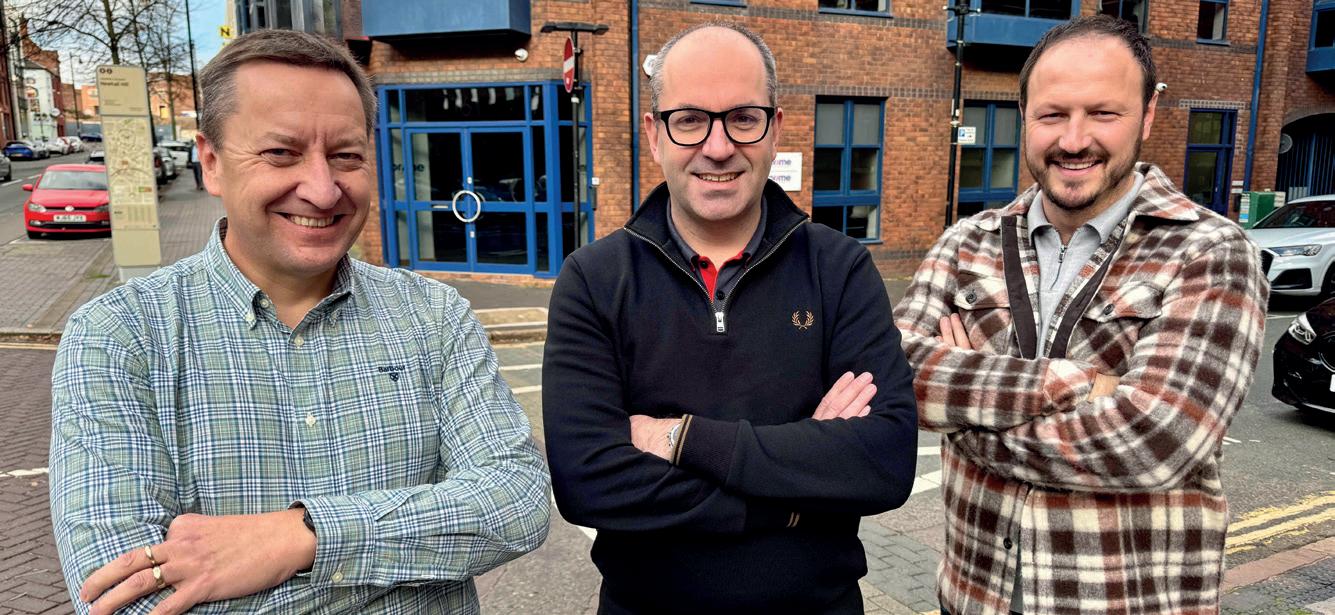
04
Accountants Grant Thornton promote Jess to Partner
Grant Thornton has promoted tax specialist, Jess Fountain to Partner. Jess has been with the firm for eight years and works with privately owned and private equity-backed clients advising on acquisitions, disposals and expansion strategies.
Jess, who lives in Bromsgrove, completed her final interview in the partnership process just three weeks before starting maternity leave, with the confirmation arriving while she was on the break.
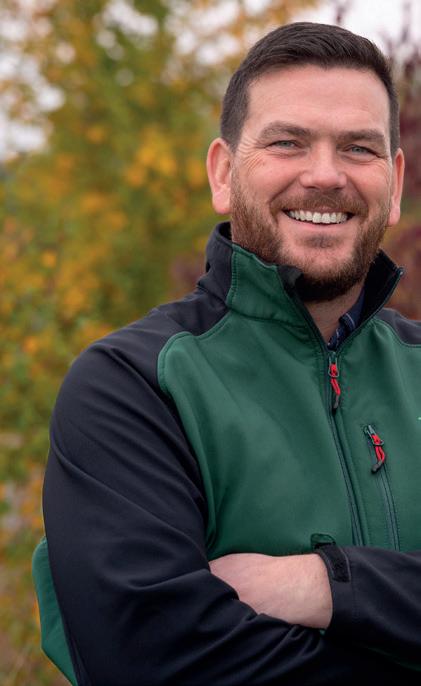


05


New Chief Exec promises greener future for Warwickshire and Worcestershire




Andy Parsons has been appointed Chief Executive of The Heart of England Forest. He moved from Severn Trent where he was Head of Property Operations.

The forest has already planted more than two million trees across 7,000 acres.



06 Midlands land and property agency expands with new hire
Richard Sanders has joined Midlandsbased land, development and property agency Newton LDP as a consultant in the firm’s growing rural team. Richard has a family farming background and joins with more than 40 years’ experience advising farming businesses, rural estates and diversified family and corporate businesses.
07 Bristol's Adaptavate appoints Tim Myatt as Head of Sales
Adaptavate, which develops low-carbon and carbon-negative building materials, has named Tim Myatt, as its new head of sales.
The company has seen high growth in the last two years, doubling the size of its team and commissioning its first pilot line to produce its first market-ready productBreathaboard.

08 Watkins works his way up at Two Rivers Housing
A former carpenter at Gloucestershire's Two Rivers Housing has worked his way up to become Director of Assets.
Chris Watkins joined the Newent-based housing association as a carpenter in 2007 and held supervisory and team leader roles within the repairs team before taking on the role of head of maintenance in 2020.
He took the newly created role of head of assets and building safety in 2022.
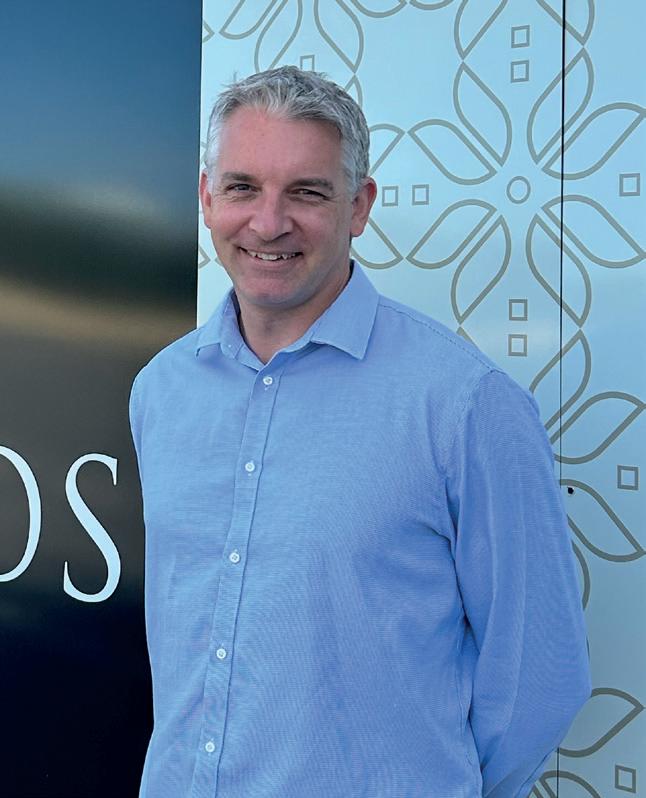

10 Sarah-Jane moves from college principal to CEO
Sara-Jane Watkins, the former principal at South Gloucestershire and Stroud College has taken over as CEO at WCG (Warwickshire College Group).
WCG includes six colleges across Warwickshire and Worcestershire, in Royal Leamington Spa, Rugby, Warwick Trident, Moreton Morrell, Pershore and Evesham.

09
New centre manager for Tewkesbury's designer outlet centre
Regional developer Robert Hitchins has appointed Adrian Field to lead the on-site management team of Cotswolds Designer Outlet in Tewkesbury, which is due to open next spring.
Adrian brings expertise in managing town and city centre destinations, shopping centres and Business Improvement Districts, having worked across the region, including Cardiff, Worcester, Malvern, Warwick and most recently in Redditch.
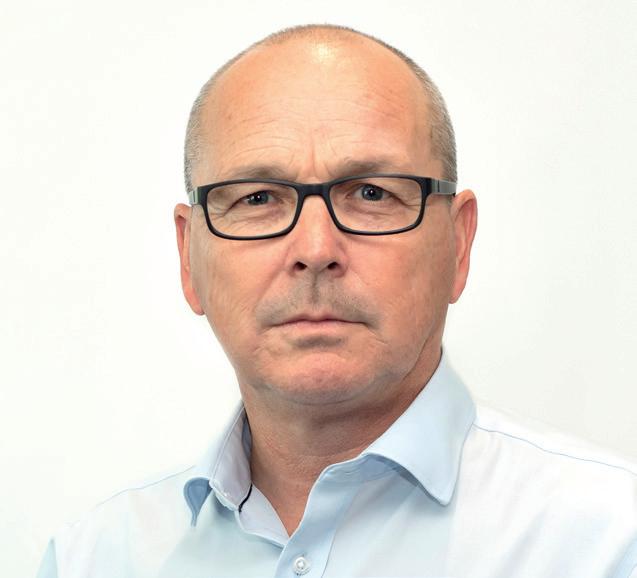
11
New chairman at Persimmon's South West division
Major housebuilder Persimmon Homes has promoted Julian Roper to the role of chairman of its South West division, taking over from Liam Scott, who is becoming deputy UK managing director and UK director at subsidiary Charles Church.
Julian has a long-standing history with Persimmon and has recently been regional managing director of the south west.
The Director of GCHQ, Anne Keast-Butler, has opened a new £5.8 million centre of excellence for cyber and digital at The University of Gloucestershire.
Funded by the Office for Students, the new centre, called FuturePark, has created a space for cyber, games and computing courses based at University of Gloucestershire’s Park Campus in Cheltenham.
Developed with Cheltenham’s cyber network CyNam and co-working cyber spaces Hub8 and Plexal, FuturePark offers state-of-the-art equipment and technology for more than 500 students on cyber, digital and computing courses at the University, the facilities offered are also available for local businesses and community organisations to use.
FuturePark aims to play a key role in cementing Cheltenham, Gloucestershire and the region as the cyber capital of the UK through its Golden Valley development.
Dame Clare Marchant, DBE, University of Gloucestershire Vice-Chancellor, said: “Cheltenham is already home to leading
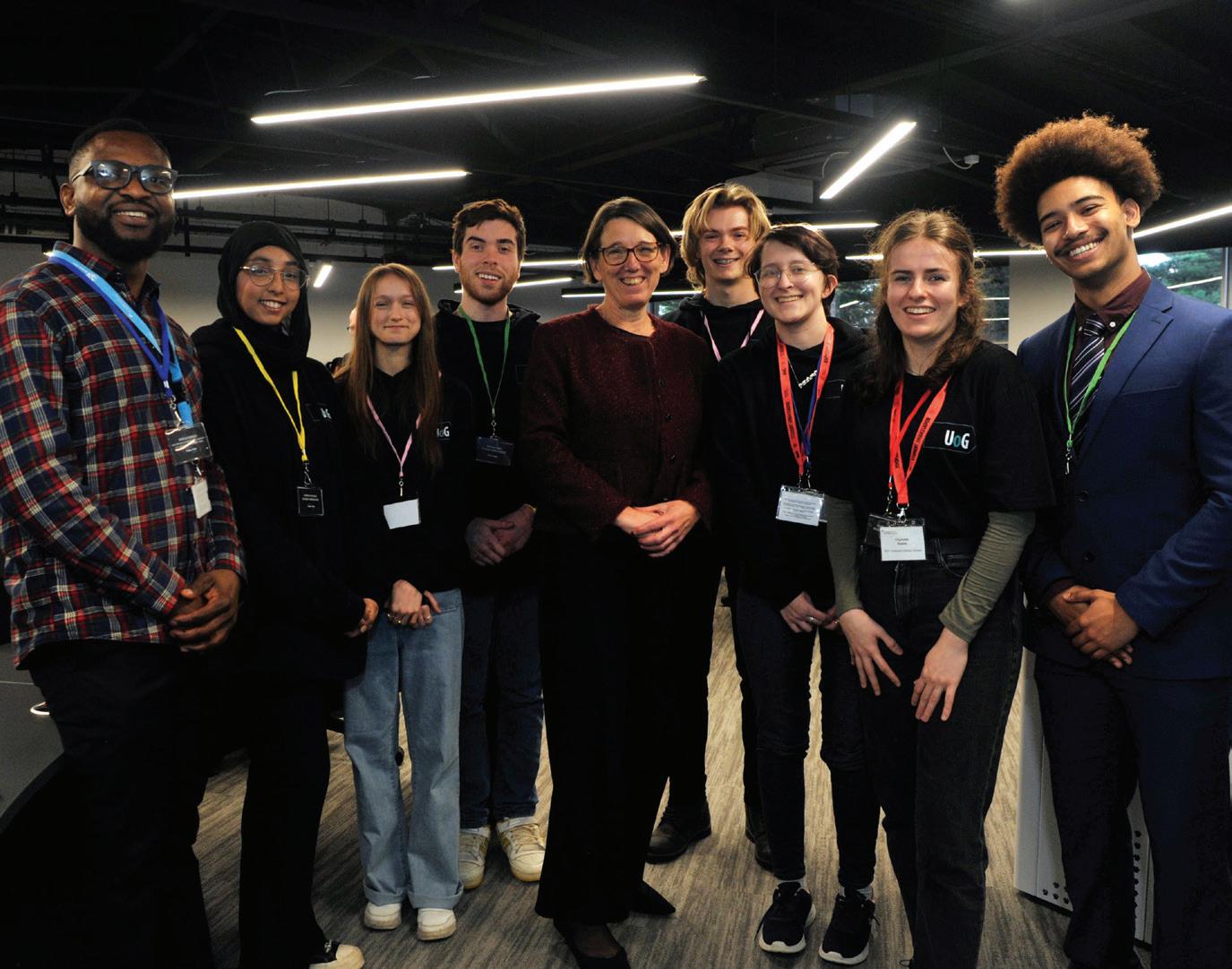
national and international organisations. We’re proud to raise the bar even higher with our own facilities. We look forward to plans for Golden Valley taking shape.
“This new space marks our commitment to Cheltenham’s vision of becoming the UK’s cyber capital and a centre of excellence for computing and digital technologies.
“It also works towards our wider vision of creating connected campuses that support our students in collaborating and building networks with each other and the wider community.
“By investing in our facilities and in the analysts, coders and designers of the future, we can ensure local employers have the skills they need to realise the region’s growth ambitions.
“At the same time, we can ensure our students and graduates are able to achieve their potential here in Gloucestershire.”
Anne Keast-Butler, Director of GCHQ, added: “It was a pleasure to open this fantastic new facility right on the doorstep of GCHQ. If we are to meet the growing challenges of an uncertain world, it is essential that we collaborate with business and our universities to nurture the talent coming through our education system.”
“This new centre will be a beacon of opportunity, providing a space to unlock curiosity and find creative solutions to the challenges we face.”
The facilities are also available for local businesses and community organisations to use.
Bristol City Council wants to invest up to £3.2 million improving its cyber security as there are serious fears that a successful attack could have “major impacts on the council’s ability to provide critical services”.
The funding will cover a growth in IT staffing and contract budgets, and
in Information Security staffing. It recommends using external cyber experts to provide a managed service.
The council said the investment would: “help reduce the risk of successful cyber-attack, the impact of which can have major impacts on the council’s ability to provide critical services over
the short, medium or long-term.”
The city council report cited the costs incurred by other councils, including the reported cost of major cyber-attacks against councils including Hackney (£12.5 million in 2022) and Redcar & Cleveland (more than £10 million direct costs).

The government has confirmed £20 million of levelling up funding for Cheltenham Borough Council’s Golden Valley development.
While it had provisionally secured the funding, the council needed confirmation that it would be granted under the new government’s plans.
The decision paves the way for the council to start drawing down the funding to continue to deliver the first phase of this unique development – the construction of the National Cyber Innovation Centre.
Cllr Rowena Hay, leader of the council said: “We are delighted that £20 million levelling up funding for the Golden Valley Development has been re-confirmed following the Budget. We have always been confident that the National Cyber Innovation
Centre will be successfully delivered. It will be a national asset that has the potential to build on Cheltenham’s place as a global leader in technology and security.
“The opportunity offered by Golden Valley not only helps us deliver jobs and prosperity for local people but will also lead to a notable transformation in nationalsecurity relations between government, academia and industry.
“The National Cyber Innovation Centre has been described as ‘a true international centre of innovation’ in the National Cyber Strategy.
“We can now continue to realise the vision and ambition of the Golden Valley Development and we look forward to working closely with all stakeholders to bring this transformative project to life.”
Businesses have been urged to boost their defences as the Cyber Essentials programme celebrates its 10th year.
The National Cyber Security Centre’s (NCSC) Cyber Essentials scheme protects against the most common cyber attacks and more than 40,000 certifications have been issued in the past 12 months.
Marking the event, the National Cyber Security Centre teamed up
with leading banks Barclays, Lloyds Banking Group, Nationwide, NatWest, Santander UK and TSB to encourage businesses to strengthen their cyber defences and adopt the Cyber Essentials scheme across their supply chains.
NCSC Deputy Director for Cyber Growth, Chris Ensor said: “The data is clear, implementing the five controls significantly lowers the risk of experiencing a cyber incident.”
The Cyber Security Body of Knowledge (CyBOK), a project that has been pivotal in the UK’s national cyber security efforts for more than seven years, is to spin out from the University of Bristol into a Community Interest Company (CIC).
This secures CyBOK’s long-term role in shaping professional cyber standards in the UK, with a growing influence internationally.
The CIC will initially be led by the current CyBOK Executive Board and will seek funding in the UK and internationally. The board will develop the CyBOK to enhance its reputation, content and global reach.
The National Cyber Security Centre’s Deputy Director for Cyber Growth, Chris Ensor said: “The NCSC has sponsored the CyBOK since its inception, supporting the development of a well-defined foundation of the cyber discipline from which specialists can learn and thrive.
“It is a truly unique resource shaped by the community for the community and I am pleased this spirit will carry through as the project becomes a CIC. I will remain a staunch supporter of its mission in the years ahead.”
Under the leadership of Professor Awais Rashid, CyBOK has become a cornerstone of cyber security research and training.
He said: “The formulation of a CIC ensures that this ethos is maintained as we secure the future of CyBOK after the National Cyber Security Programme funding ends.”
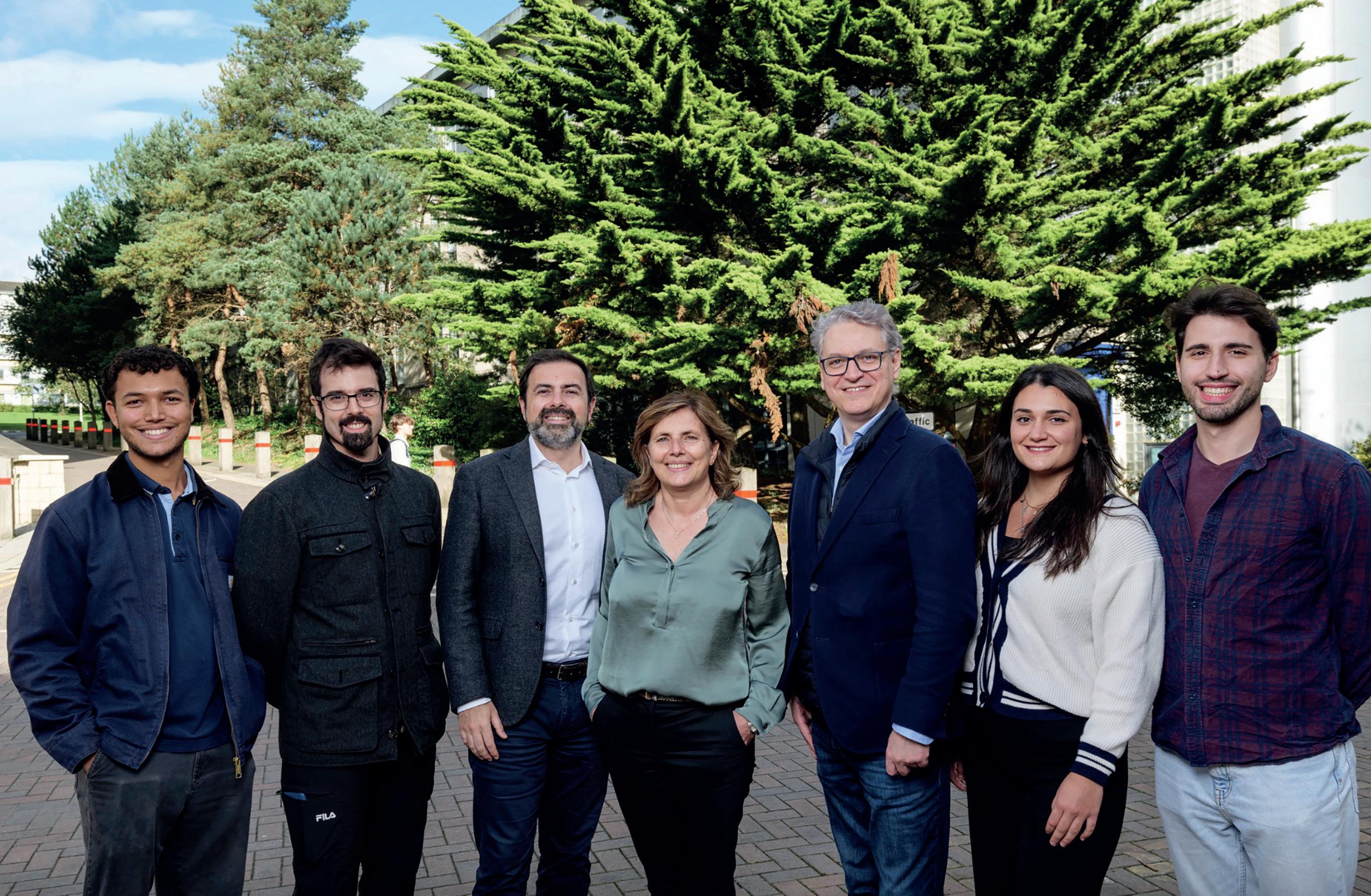
Bath university start-up Naturbeads has secured £7.8 million of series A funding to advance its pioneering technology.
The company, which spun out of the university in 2018, has developed a process to manufacture biodegradable cellulose microspheres to replace microplastics in many consumer and industrial products.
It was developed by co-founders, CTO Professor Davide Mattia, CEO Giovanna Laudisio, and the late Professor Janet Scott.
The company is poised to build its first production plant in Italy and the funding will enable it to significantly increase production capacity.
Giovanna said: "Our differentiator from other companies who are trying to solve challenges around plastic packaging, is that we are one of few that are solely focused on the plastic found within daily products,
and producing an eco-friendly, scalable alternative."
Microplastics – plastic particles which are less than five millimetres – persist in the environment for hundreds of years, contributing to pollution.
EU regulations to ban their use in cosmetics and other products were published in October 2023, with a view to phasing out rinse-off products like shampoos and face washes by 2027.
This is set to be followed by the phasing out of further personal, home care and agricultural products.
Naturbeads is collaborating with a number of global manufacturers to integrate its cellulose microsphere ingredients into various industrial applications and expects to announce its first commercial milestones this year.
Our differentiator from other companies who are trying to solve challenges around plastic packaging, is that we are one of few that are solely focused on the plastic found within daily products
As part of its 60th anniversary celebrations, The University of Warwick is launching its first Festival of Innovation and Grassroots Growth Summit this month.
Professor Stuart Croft, ViceChancellor of The University of Warwick, said, “This is an opportunity to take stock of the achievements of the past six decades. It is also a chance to renew our commitment to a further 60 years of innovation and collaboration.
The all-day, free-to-attend festival will feature hands-on exploration of the university’s work in CleanTech, HealthTech, AgriTech and CreaTech.
Innovations on show will include pioneering sense-based Alzheimer's taste-test screening, the sewage powered Waste2Race Le Mans Prototype race car, an immersive gaming and scent experience, new technology from the Clean Transport Accelerator (in collaboration with NatWest), autonomous vehicles and agricultural robots.
Alongside this, the University’s Warwick Innovation District is hosting an entrepreneur, founder and SME Grassroots Growth Summit, which will connect businesses with organisations, academics and others who can help them.
David Plumb, Chief Innovation Officer at The University of Warwick, said: “The Festival of Innovation and Grassroots Growth summit will celebrate our innovative spirit –something that was born 60 years ago and continues to be at the core of our work.”



The SETsquared Partnership of six universities have announced plans with leading regional investment firm QantX for a new £300 million spin-out focused investment vehicle to catalyse the creation and growth of science and technology companies addressing global challenges.
Combined, the SETsquared Partnership of Bath, Bristol, Cardiff, Exeter, Southampton, and Surrey universities – has a research portfolio of more than £600 million and produced more than 230 spin-out companies.
The initiative was announced by Sir Richard Olver, Chair of QantX, at a Regional Investment and Health & Life Sciences Summit, also attended by Science Minister Lord Patrick Vallance and MP Darren Jones.
This new investment vehicle will provide much needed early-stage patient capital, expertise, and support available to university spin-outs and start-up companies in the region working in areas of true global impact – such as sustainability, clean energy and transformative healthcare.
Despite this success, the potential impact of research and development to power regional growth and productivity is being held back due to significant imbalances in equity funding across the UK.
Start-ups in the region raise, on average, five times less at early stages than in the Golden Triangle of London, Oxford and Cambridge.
It is hoped that this new vehicle will open up significant co-investment opportunities, and de-risk early stage investments for the venture capital and angel investment community, and increase the overall amount of capital available.
QantX has backed a number of science and technology founders and developed connections across university innovation ecosystems.
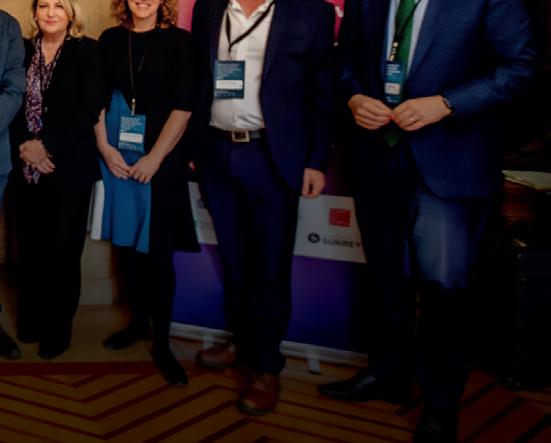
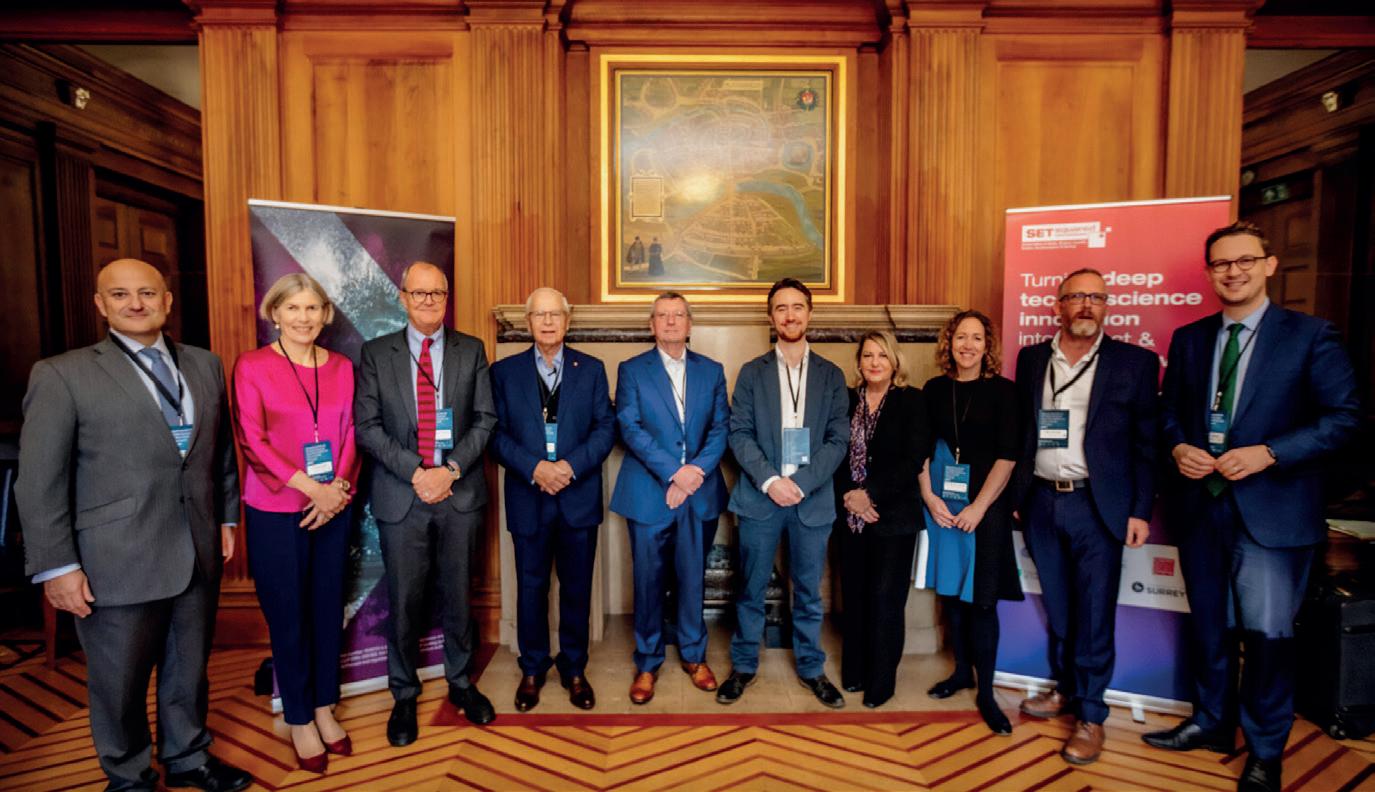

SETsquared is one of the UK’s most successful innovation partnerships and was recently ranked by the Financial Times and Sifted as one of the top three start-up hubs in Europe.
SETsquared Bristol is part of the University of Bristol, which has a growing portfolio of spinout companies in fields such as quantum computing, artificial intelligence, clean energy and health technology, and the new investment vehicle will help cement Bristol’s reputation as a thriving hub for world-leading tech companies.
The University’s new Temple Quarter Enterprise Campus, due to open next year, sits in an emerging innovation district in the city.
Science Minister, Lord Patrick Vallance said: “The UK is home to brilliant innovators, and this investment vehicle will help turn great ideas into thriving companies that create high-skilled jobs and exciting new products.”
Richard Haycock, Co-Founder & CEO, QantX, added: “While the UK ranks fourth globally in cutting-edge research and innovation, we’ve often struggled to commercialise these breakthroughs. Our partnership with the SETsquared universities aims to change this in the south and south west.”
Marty Reid, Executive Director, SETsquared, continued: “The potential scale and quality of science and technology companies emerging from across the SETsquared university clusters is a match for any ecosystem.
“We are delighted to formalise our collaboration with QantX, who bring a wealth of complementary experience from global industry and finance and a shared ambition to build a truly world-leading regional ecosystem.”
Fire protection supplier Argus Fire (West Midlands)

has been acquired by Facilities management group Mitie (London)
Sellside advisers include Gateley Legal, Headpoint
RHC Lifting (Bristol)

has been acquired by Lifting equipment supplier WH Scott Group (Ireland)
Palletising (Netherlands)

has been acquired by Automation provider Mpac Group (Coventry)
Buyside advisers include Osborne Clarke
Accountants Elliott Bunker and Tyler Redmore (Bristol)

have been acquired by Accountants Charlton Baker (Wiltshire)
Buyside advisers include ThinCats, CTCF, Translink Corporate Finance, Irwin Mitchell, Clarion

has received investment from Investor BGF (London)
Advice network The Openwork Partnership (Wiltshire)
Accountants Mitch Consulting (Bristol)

has merged with Accountants Streets Steele (Bristol)
Buyside advisers include Streets Law
Sellside advisers include Ashtons Legal
Antenna supplier Q-Par Antennas USA Tech reseller Kubus (Gloucestershire)

has received investment from Investor Bain Capital (US)
Buyside advisers include Slaughter and May
Sellside advisers include Stephens, Addleshaw Goddard, Burges Salmon
Solar installer Amelio Enterprises (Lincolnshire)

has been acquired by Renewables supplier Good Energy (Wiltshire)

has been acquired by Electronics manufacturer Solid State PLC (Worcestershire)

Refrigeration provider Cold Tech Services (Bristol)

has been acquired by Investor Nene Capital (Northamptonshire)
Sellside advisers include EvolutionCBS, Mackrell Solicitors
Little Soap Company (Worcestershire)

has secured funding from Lloyds Bank (London)

has been acquired by FutureLife Group (Czechia)
Buyside advisers include Grant Thornton
Sellside advisers include Gardner Leader
Among the top tips and high profile failures written about mergers are estimations that as many survive as marriages – roughly 50 per cent.
Businesses are fond of declaring that their “people are their greatest asset” and that is often true. Upon a merger, completed or pending, corporate PR machines go into overdrive. Once they’ve signposted the headline commercial rationale, they announce the shared ambitions, complimentary principles, aligned values and common cultures.
Countless examples and the experiences of employees show us that while merging entities invest heavily in the optics (PR and internal communications), some stop there. Those boards, executives and investors hold their collective breath, hope that integration is
smooth and that teams adapt. Meanwhile, employees are faced with a seismic shift – new colleagues, characters, management and structure.
New policies, procedures, software and systems, an empowering, collaborative and trusting management style may yield to something more autocratic and transactional, or vice versa. Changes, which may involve saying goodbye to people and premises, can be extremely unsettling. It is too often forgotten that employees have human reactions to big changes. Productivity can be the loser.
Increased employee engagement is known to boost productivity and profitability. The ingredients of engagement are workplacebased but are clearly rooted in human needs – trust, valuing one’s
work,opportunity, recognition, role clarity etc. Organisations are getting better at listening, but it is incumbent on the leadership of merging businesses to check-in on their “greatest assets” before, during and after M&A.
Boards should insist on formal and informal information gathering, human interaction and the provision of an independent channel for employees (and other stakeholders) to share their views and concerns around any merger.
Mergers are marriages. Some need more work than others. Few survive significant impact without excellent communication with the people involved being at the very heart of the discussion.
Rory James-Duff Orwell Independent Ltd www.orwellindependent.co.uk



and could be bought
In October, Chippenham’s Good Energy announced that it had bought Lincolnshirebased Amelio Enterprises Ltd for up to £6 million and Hampshire solar design and installation company Empower Energy for up to £8 million.
In that same month came the news that Good Energy itself had received an unsolicited offer to be bought by Dubaiheadquartered Esyasoft.
Esyasoft is pioneering the supply of AIpowered technology and analytics solutions for worldwide energy transition projects.
On its solar purchases, Good Energy’s CEO Nigel Pocklington, said: “Businesses are increasingly recognising that the commercial rationale for installing solar is strong, even before you consider the benefits of carbon reduction.
“As the third and fourth solar acquisitions Good Energy has made in 18 months, we have rapidly scaled our service coverage and capability. We will now focus on integrating these businesses under the Good Energy brand, leveraging our increased scale and integration to provide a cohesive experience for commercial customers looking to cut their energy bills and carbon through installing solar.”
But back to the possible sale of Good Energy itself. Esyasoft announced its
intention on October 28, and had until November 25 to either announce a firm intention to make an offer for the company or announce that it does not intend to make an offer. With nothing forthcoming on that date, it was given further time to carry out due diligence.
By the time you read this, we should know for sure whether the Dubai company is going ahead.
Good Energy was founded in 1999 as a new kind of energy company – green and sustainable when most of our energy was still using coal, gas and nuclear.
The founder, Juliet Davenport, had been working for an energy environmental consultancy were she analysed policies on renewable energy strategies around Europe and developed technology models.
The company’s first purchase was the Delabole wind farm in Cornwall, the UK’s first commercial wind farm. By 2012 the business had launched on the London Stock Exchange’s AIM market. Over that year it raised £4 million to drive growth.
Juliet stepped down as CEO in 2021 and was succeeded by Nigel Pocklington to drive the next stage of its development. Since then it has expanded into solar and heat pumps and last year became the UK’s only B Corp home energy provider.
Redditch-based Solid State, a component supplier and design-in manufacturer of computing, power, and communications products, has acquired Q-Par Antennas USA LLC for up to $2 million.
This provides the Worcestershire firm with an opportunity to further invest in the medium-term growth opportunity in the US markets.
Q-Par will join the systems division of the group.
Established a decade ago, Q-Par provides antenna systems and related technologies, mainly for defence and security applications
Gary Marsh, CEO of Solid State, said: "The acquisition of Q-Par Antennas secures a valuable distribution channel and gives the group an opportunity to further invest in the medium-term growth opportunity in the US markets.”

Mpac Group, the London-listed business which automates manufacturing lines, is acquiring Dutch company Elstar International B.V. (trading as CSi Palletising), which designs and manufactures end-ofline automation and palletising solutions.
The deal is worth £47 million, however completion of the acquisition depends on approval by the Romanian Competition Council, and certain resolutions put before Mpac’s shareholders.
Adam Holland, Chief Executive at Coventry-based Mpac, said: “The acquisition of CSi Palletising will, along with our recent acquisitions of BCA and SIGA Vision, significantly transform our customer offering and core capabilities.
“We’ve substantially expanded the breadth of our technology and extended our customer reach globally.
“We’re excited about the growth opportunities for the enlarged group.”
Jan de Bruijn, Chief Executive at CSi Palletising, added: “The combination of these two companies represents a strong fit with the strategic plans that CSi Palletising has made in the past for its Dutch, Romanian and Mexican subsidiaries.
“There is a good cultural fit and it increases the possibilities for CSi Palletising colleagues to develop themselves further on an international scale.
Cirencester technology value-added reseller (VAR) Kubus has secured investment from BGF.
Founded in 2003, Kubus focuses on networking, server and storage infrastructure along with cybersecurity and now works with blue chip clients and public sector organisations around the world, including Juniper Networks, Cisco, Dell, Fortinet and Pentera.
In the year ending March 31, 2024, Kubus posted a turnover of £35 million and EBITDA of £2.6 million.
The £9 million investment from BGF will help the company grow via targeted acquisitions, strengthen its operational infrastructure and explore new market opportunities.
The leadership team has also
welcomed experienced non-executive chair Paul Brennan via BGF’s Talent Network.
Paul focuses on fast-growth technology and tech-enabled businesses, having sat on the board of Bristol-based software provider Amdaris (which was acquired by Insight Enterprises Inc in 2023 after BGF’s exit).
Andrew Humphrey, CEO of Kubus, said: “We’re thrilled to partner with BGF and leverage their expertise and resources to take Kubus to the next level.
“As a business based in the heart of the Cotswolds, we’re proud to be working with businesses and organisations across the world.
“This investment will allow us to accelerate our global growth plans,
“This is the best possible next step for CSi Palletising.”
A large international team from Bristolbased Osborne Clarke advised on the transaction.
This included colleagues from the Netherlands, Germany and Belgium.
The UK team comprised Louise Grzasko, Stuart Miller, Rebecca Ewing and Liam O'Connor (corporate); Ben Truman, Clara Hutchison, Saskia Zant-Boer (banking) and Simon Neill, Marc Shrimpling and Freddie Carter (competition). Osborne Clarke also worked with relationship firms in Romania, Canada, Mexico and the US.
innovate faster and deliver even greater value to our customers.
“With the added support of Paul in his new role as non-executive chair, the road ahead looks very exciting indeed.”
The deal was led by Edwin Davies and Louis Hall, investors in BGF’s South West team.
Edwin added: “With strong vendor relationships and a longstanding blue chip customer base, Kubus has demonstrated impressive growth and innovation in the technology sector.
“We believe they’re well positioned to capitalise on the strong market opportunities ahead and look forward to working alongside Paul and the Kubus management team on their growth journey.”


The number of young people starting apprenticeships rose last year, albeit marginally. But the government’s new, flexible, growth and skills levy could boost this further
By Nicky Godding
The number of young people on apprenticeships rose slightly last year, to 278,590.
Advanced apprenticeships accounted for 43 per cent of starts while 36 per cent were on higher apprenticeships.
They started, but did they finish? The latest figures on those who go on to complete their apprenticeships come from the previous year (2022/23). They reveal that just over half successfully completed their apprenticeships. While this is an increase on the previous year, it’s still below the government’s 67 per cent target.
This year’s week-long celebration of apprenticeships bringing together businesses and apprentices runs from 10-16 February.
It takes place against a backdrop of welcome government changes to the much-criticised apprenticeship levy introduced in 2017 by the then Chancellor George Osborne.
Ever since it was introduced, the
apprenticeship levy has attracted widespread condemnation for being too restrictive.
Among a number of issues, businesses could only spend the levy on very specific types of training and couldn’t use the money to fund courses shorter than a year.
The levy required large organisations to set aside 0.5 per cent of their payroll for apprenticeships, and if they didn’t use the money within two years it would revert to the treasury.
But almost from the get-go, trade bodies across the UK complained that it wasn’t fit for purpose. In a letter to the previous government in January 2023, UK Hospitality, the British Retail Consortium, TechUK and the Recruitment and Employment Confederation said that a skills levy should give employers flexibility to invest in their workforce through short, modular courses and online learning.
They added that none such courses could be funded through Apprenticeship Levy funds, £3.5 billion of which has expired
since 2019 because businesses were unable to spend it.
Unencumbered by a commitment to previous legislation, the new Labour government says it will replace the apprenticeship levy with a new “flexible” Growth and Skills Levy.
This will allow funding for shorter apprenticeships, but it has yet to confirm more details and is also asking employers to rebalance their funding for apprenticeships to invest in younger workers.
This is also likely to mean the scrapping of funding for level 7 apprenticeships –equivalent to a master’s degree and often accessed by older or already well qualified employees, which will now sit outside the levy.
The Association of Employment and Learning Providers (AELP), the national
Businesses need a highly skilled workforce to draw on if they are to drive economic growth and expand opportunity in our communities
membership body which represents training and vocational learning providers, has welcomed the reforms, but raises concerns over the cutting of level 7 apprenticeships.
AELP said that the evolution of the current apprenticeship programme, including introducing shorter foundation and midcareer apprenticeships alongside the core apprenticeship programme, means there is scope for significant growth in participation to more than half a million apprentices a year, an increase on the current participation rate of nearly 50 per cent.
It is recommending maintaining the employer-led, all-age, alllevel apprenticeship programme and introducing both a foundation apprenticeship to support more young people/SME training routes and an impactful mid-career apprenticeship programme for upskilling adults.
It also suggests increases the apprenticeship programme budget
from the levy take to facilitate new nonapprenticeship funding flexibilities as part of the commitment to reform the levy and system.
Last September, Bridget Phillipson, the Secretary of State for the Department of Education, said: “The first mission of this government is economic growth. Central to this mission is a skills system fit for the future. Businesses need a highly skilled workforce to draw on if they are to drive economic growth and expand opportunity in our communities.”
But many businesses find the qualifications landscape to be opaque.
In its first report, Skills England – the government’s new arms-length body to drive the country’s skills agenda, says that skills supply may be mismatched against demand, and there are insufficient
mechanisms for encouraging employers to invest in skills.
It also says that employer investment in training has been in steady decline over the past decade. Training expenditure is at its lowest since the introduction of the Employer Skills Survey in 2011, with investment per employee down by 19 per cent per cent in real terms.
Demand for occupations and associated skills also differs across industries. The health and social care industry has the highest volume of roles in demand. Other high demand occupations include those in the education, manufacturing and professional scientific and technical industries.
And the future skills landscape looks different again, with the impact of demographic and technology shifts, as well as the transition to more green skills.
Many of the occupations currently in demand are also those projected to see employment growth in the future, including those in health, social care and life sciences, green jobs, AI, creative industries and service-orientated roles.
Occupations requiring higher education (such as building and civil engineers) and interpersonal skills (such as youth and community workers) are expected to see the most employment growth by 2035.
Bristol and Gloucestershire waste management company Grundon hosted the company’s first-ever Grundon Graduation, celebrating successful apprentices from the past 12 months.
Managing Director Clayton SullivanWebb presented each apprentice with a certificate, personalised apprenticeship lanyard, and a bespoke Apprenticeship Graduation hi-vis jacket as a token of their accomplishment.
He said: “Every apprentice not only passed but many passed with distinction. Grundon’s distinction rate is well above the national average.”
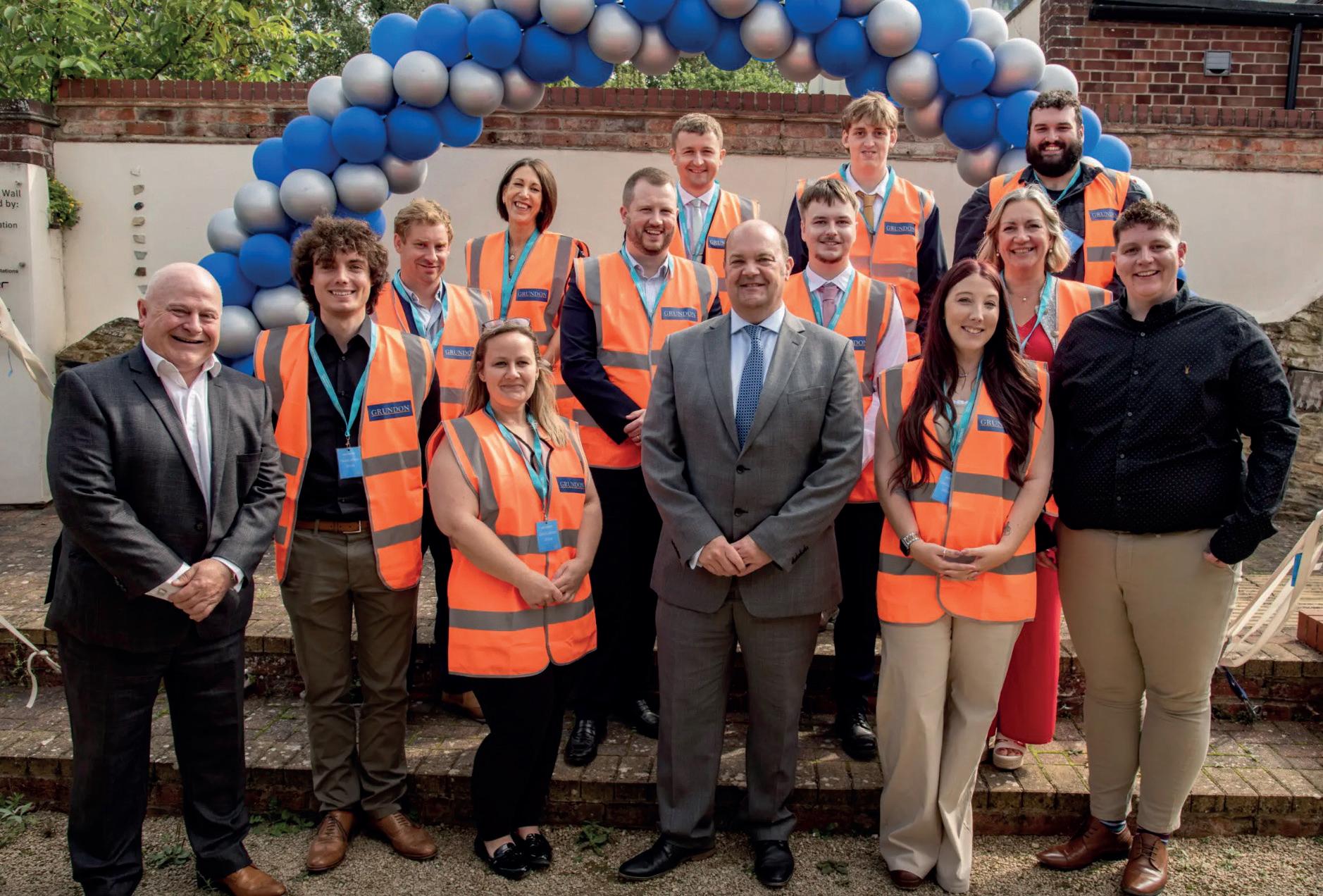
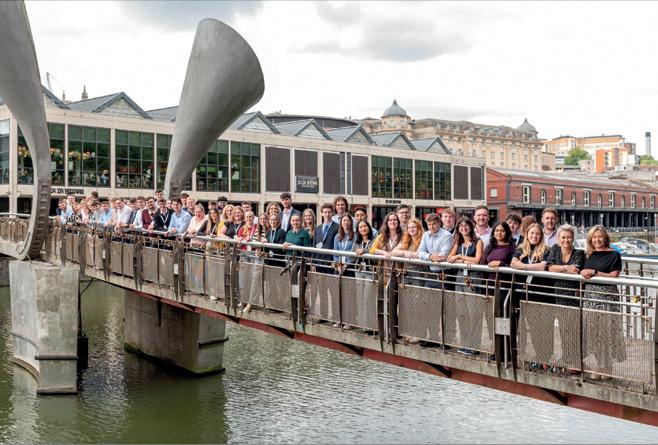
South West accountancy firm













Bishop Fleming welcomed a recordbreaking 75 new apprentices into its business in September, marking a fifth consecutive year of growth in apprentice recruitment.
This record intake, which includes 50 university graduates, 22 schoolleavers, and three placement students comes just four years after the firm became an accredited Apprenticeship Employer Provider.
The new Level 7 apprentices will be spread across the firm’s eight offices in Bath, Bristol, Cheltenham, Exeter, Plymouth, Torquay, Truro and Worcester. Each trainee will undergo an extensive 100-day induction programme as they begin their qualifications from the Institute of Chartered Accountants in England and Wales (ICAEW), with whom Bishop Fleming are a ‘Partner in Learning’.
Anna Averis, Partner and Chief People Officer for Bishop Fleming said: “We have ambitious growth plans and our record-breaking number of apprentices yet again this year is testament of our commitment to invest in new talent into our business.
“As one of the few accountancy firms in the UK to have Employer Provider status it is fantastic to see that our own tailored apprenticeship programme continues to go from strength to strength."
The Best Connection, a leading provider of temporary workers, has celebrated training 100 apprentices since becoming an official employer provider in 2021.
Neil York, Director at the Bromsgrovebased company, said: “Seeing 95 per cent of our students achieve Distinction grades is a testament to our team’s hard work and the quality of our programmes.
“Our focus has always been on providing meaningful and impactful training that not only benefits our apprentices but also contributes to the broader recruitment industry.”
The Best Connection specialises in recruiting high quality temporary workers for the industrial, driving, retail, e-commerce, distribution, warehouse, aviation and care sectors. It has access to more than 300,000 temporary workers across a network of more than 85 branches.
The Best Connection Group, as part of the SWS Group of companies, transitioned to an Employee Owned Trust model in 2024.

The Real Outdoor Xperience, formerly South Cerney Outdoor, is offering what may be the most adrenaline-filled apprenticeships in the UK.
The company has been listed in the top 50 SME apprenticeship employers in England both of the last two years.


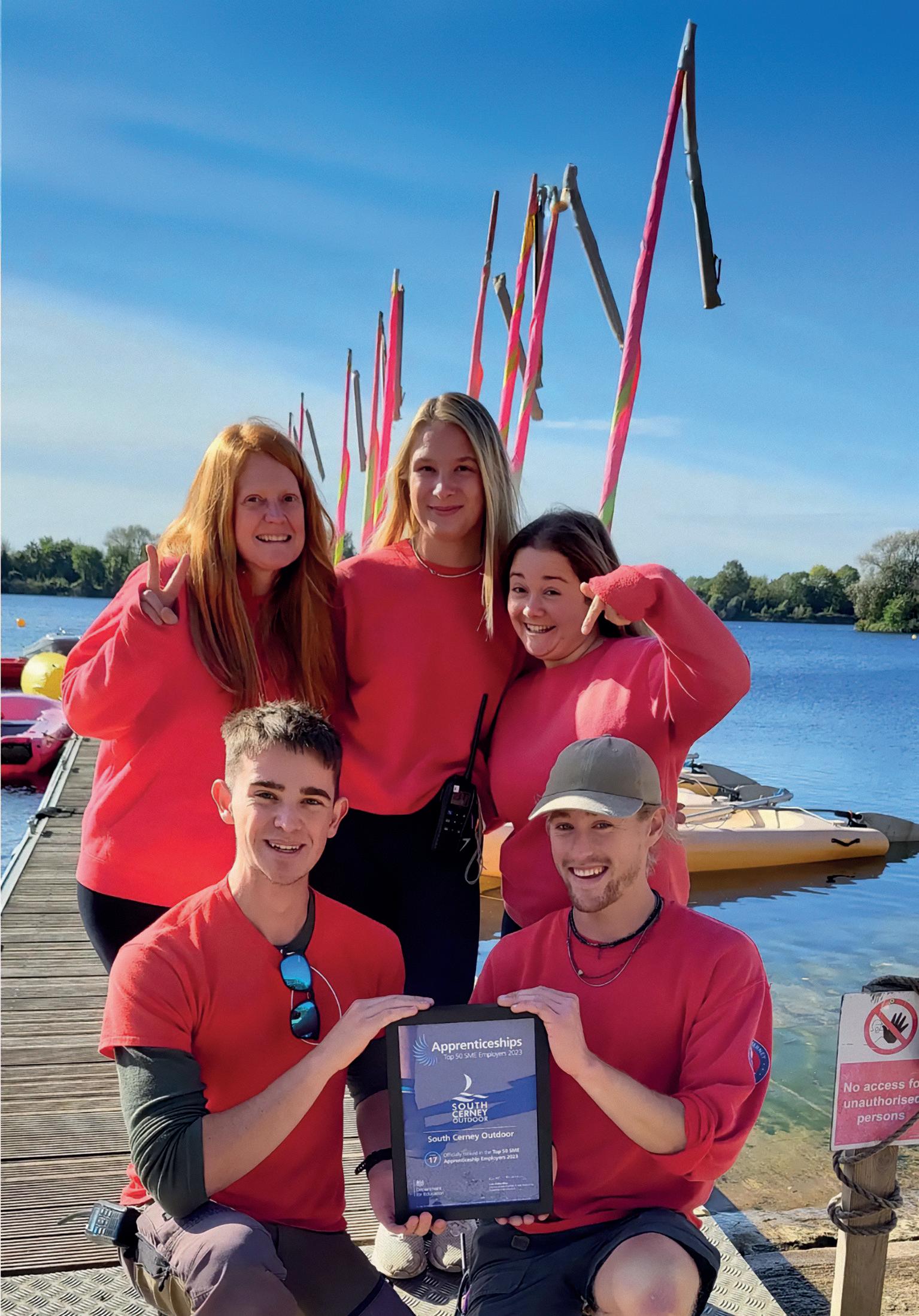
Swindon accountants Monahans has been named one of England’s Top 50 SME Apprenticeship Employers for 2024.
Within the Professional Services category, Monahans now ranks seventh nationally and Number One for the South West region.
Over the past 12 months, the firm has seen a record number of apprenticeships completed.
Monahans says the apprenticeship programme is about more than just helping apprentices succeed, it’s also a smart business strategy.
It said: “We understand that to have a successful firm, there needs to be a constant stream of high-quality talent and our apprenticeship scheme allows us to reach young professionals eager to learn and grow.
“Additionally, as an apprenticeship levy-paying employer, we’re able to recoup some of the training costs. This allows us to reinvest in other areas of the business.”
Ellie McQuade, Technical Learning and Development Manager at Monahans, said: “I am proud of the recognition that the apprenticeship scheme has received and we have ambitous plans to continue investing in talent.”
A report published last October by EngineeringUK, the not-for-profit company helping to grow the sector’s talent pool, reveals that people working in engineering and technology occupations were significantly more likely to earn more compared to the average across all other occupations combined.
Their gross pay was on average more than £39,000.
The report found the sector employs 6.3 million people in the UK. A fifth of the workforce (employed and self-employed) were working in an engineering and technology occupation in 2023.
A further 10 per cent were working in the industry – although not in an engineering or technology occupation – such as in HR at an engineering or technology company.
The engineering and technology sectors are predicted to grow faster than any other sector between now and 2030 and those working in engineering and technology are significantly more likely to have completed an apprenticeship compared to all other occupations combined.
But a study carried out by The Engineering Construction Industry Training Board predicts by 2026, 91,000 engineers, nearly 20 per cent of the current UK engineering workforce, will have retired or be just about to. Additionally, they predict 29,000 technicians, which is nearly 18 per cent of the current technician workforce will have retired.
Worryingly, minority ethnic groups continue to be under-represented in engineering and technology jobs, and there has been a decline in the percentage of women in engineering and technology occupations.
To support and inspire more young people to go into science, technology and engineering, Engineering UK has launched EUK, a new brand offering teachers and careers adviser support. The new one stop shop EUK site brings together STEM programmes and best free STEM education and career resources.


What interesting projects have you worked on so far?
What made you choose a cyber apprenticeship as a career route?
I’d always wanted to work in computing and cyber has always seemed like a great option. While I was going through university applications, I’d heard about degree apprenticeships being a good alternative. I did some research and realised that something more practical alongside academic studies would definitely suit me best.
What is your day-to-day role like?
The constant focus is always on learning. Different placements provide opportunities to get hands-on with current tech like networking devices, machine learning models and threat-hunting technologies.
Placements provide an opportunity to really delve into a topic and you can always lean on the expertise of colleagues to supplement that research. Currently, I’m taking on more of a networking role in designing and implementing a new company network which is proving challenging but still fun.
Now that I’ve moved into my second year, I have taken on greater responsibility, partly due to my new role as STEM colead for the Bristol site. Managing STEM events and ensuring that everyone can get involved has been a challenge, but it’s always really rewarding.
Looking back on my first year, I’ve had opportunities to work on a wide range of projects. Among them has been developing a demo around how AI systems can be compromised and, conversely, how they can be secured. The project was really interesting and required me to improve on and build new skills including programming, research techniques and even public speaking.
What has been the best thing about your cyber apprenticeship?
The variety. Being able to work alongside colleagues in various fields and disciplines has been fantastic.
It’s really given me the opportunity to consider each department and how I might work within those teams. It is truly the best environment for me to consider my career.
What has been your biggest achievement at Leonardo so far?
It was probably a presentation I delivered alongside another apprentice to the entire Bristol site. It covered the basics of Artificial Neural Networks and was quite possibly the most nerve-wracking experience I’ve ever had.
Overcoming that anxiety felt incredible, and as the presentation progressed, I felt more confident. That experience has had a really positive impact on my public speaking ability and my self-confidence.

Global engineering technology business
Renishaw welcomed 63 apprentices this year among 220 new recruits through its early careers programme.
Along with its apprentices, the company has taken on 100 graduates, and 57 industrial placement students.
Renishaw’s Early Careers programme offers a wide range of schemes and encourages applicants from a diverse range of backgrounds with different skills and experience.
It includes roles in communications, software, mechanical engineering and physics.
Applications for Renishaw’s award-winning apprenticeship programme opened at the beginning of December and runs until the end of February 2025, offering positions across a range of roles
Renishaw apprenticeships are full-time, permanent jobs that give provide formal training alongside work placements.
Renishaw has always placed huge value on our Early Career’s programmes ...
Simon Biggs, Early Careers Manager at Renishaw, said: “Renishaw has always placed huge value on our early careers programmes as we are focused on building a diverse workforce that can meet future challenges.”
To welcome the latest additions to its early careers programme, Renishaw organised a team-building weekend retreat in Wales, including activities such as climbing, canoeing and archery.
Richard Parker, who was elected Mayor for the West Midlands last May, has committed to providing 20,000 work experience placements, training opportunities and apprenticeships training.
Youth unemployment in the West Midlands is currently twice the national average, with many young people lacking the skills needed for modern industries.
“Our region has the youngest population in Europe, and we need to make sure they have the skills and opportunities to succeed,” he said.
“We are already supporting young unemployed people get into apprenticeships with our Path 2 Apprenticeship programme in which we have invested £7.5 million to support 3,300 young people over three years.”




A record number of students, educators and some of the South West region’s biggest employers descended on Cheltenham Racecourse late last year.
The event, organised by growth consultancy C2S, brought together 1,800 students from 30 county schools to connect with more than 55 South West businesses during its Educational Outreach Live event.
Every sector and size of organisation was represented, showcasing the outstanding SMEs, global giants, entrepreneurs and
family businesses in the region to inspire the next generation of talent and support business growth across the county for years to come.
Supported by Gloucestershire County Council and local MP Max Wilkinson, C2S Educational Outreach Live gave businesses the opportunity to meet and talk with pupils about future career opportunities, T-Levels, apprenticeships and jobs.
Angela Edwards, Co-founder and Director of C2S, said: “The UK business sector
needs an influx of new talent, and if we don’t provide obvious pathways into professions for our young people, it will be difficult for the economy to advance over the next 10 to 15 years.
“This is why we have worked closely with businesses in the Gloucestershire regions, many of whom are members of C2S, to showcase to pupils what fantastic employers and future career opportunities are available on their doorstep, as well as giving them the chance to win a work experience placement.”
This year the event also incorporated leading regional cyber cluster, CyNam’s EmPowerCyber24 event, designed to attract more pupils, particularly girls, into a career in cyber.
Lucy Blick, Associate Assistant Headteacher at Gloucester Academy, said: “Opportunities like this are really rare and provide young people with the knowledge and confidence to make informed decisions about their next steps.”
MP Max Wilkinson, said: “Helping young people gain the skills and confidence they need to explore the jobs market is so important. This sort of event strengthens education and industry, while building a brighter future for our community and strengthening our economy.”
Ian Menzies, General Manager at L3Harris Technologies said: “As the proud headline sponsor of C2S Educational Outreach Live, L3Harris Technologies fully supports the goals of the event, from helping students gain a better understanding of the workplace to increasing awareness of early careers opportunities within the region.”
Worcestershire’s annual Apprenticeship Awards marked their 10th anniversary last year with the programme setting a new record for the number of finalists.
More than 315 representatives from employers, apprentices, schools, training providers and ambassadors attended
the West Midlands Safari Park for the celebration.
A total of 12 winners were crowned. The Worcestershire Apprentice of the Year was named as Dillon Ford from Kidderminster-based solid propulsion systems manufacturer Roxel Group UK. Worcester-based global industrial
machine manufacturer, Yamazaki Mazak UK, was named Worcestershire Apprenticeship Employer of the Year.
Worcestershire Apprenticeships has supported more than 30,000 young people around apprenticeships, delivered 1,300 activity sessions and events and helped 2,000 employers.
Warwickshire engineering company
Kigass, which was established more than 100 years ago, is investing in young engineers of tomorrow.
With long-standing clients such as the Ministry of Defence, Rolls Royce and F1 on its books, the company is ensuring its experienced engineers are supporting the next generation.
Among the younger generations are Jake Robbins, 22, and Jay Reading, 23, who started with Kigass six years ago and have now completed their apprenticeships.
Phinley Allton, 18 and Francesco Cunsolo, 20, began their apprenticeships last September.
Dominik Lysik, 24, from Coventry, started his apprenticeship with a local company where he had worked for three years. He transferred to Kigass in August last year when his previous employer closed down and he found himself out of a job.
He is now working towards completion of his Level 3 Engineering Technician NVQ and an HNC.
He said: “Thankfully I could pick up with my apprenticeship here from where I left off.
“I feel I’ve had more support than where I was before and a lot more variety. That’s the thing I’m most excited about.”
Jake Robbins said: “I didn’t know too much about engineering at school. I had thought of it as making things but there is so much more to it – like working to tolerances. This is just not something that would have been on my radar at school but it’s something I’m really enjoying.”
Jay followed in his grandfather’s footsteps, joining Kigass more than 25 years after his grandfather worked there.

There is so much opportunity to develop within the company and we see so much potential ...
Francesco said: “I went to university for a couple of months to study psychology, but it wasn’t for me. Everyone at my school was enrolling for university so I felt I didn’t want to miss out. But while I was studying for my GCSEs, I went to an engineering school and there were a lot of people there doing apprenticeships. I felt it would be perfect for me.
“Kigass is smaller than some of the big firms so I feel there is more focus on me and I have more opportunity to become involved.”
Jay said: “We want to see Kigass continue to go forward and we want to progress with it and be a part of its long and exciting journey.
“There is so much opportunity to develop within the company and we see so much potential to continue building something even bigger.”
BAE Systems is projecting a record number of young people in training in 2025 and the company’s investment in education and skills is expected to reach £1 billion since the start of the decade.
With major sites across the South of England and Bristol, BAE Systems is recruiting for more than 2,400 new apprentice, undergraduate and graduate roles in 2025, which will result in a record number of 6,500 in training, making up approximately 15 per cent of its UK workforce.
An anticipated £230 million investment in education and skills next year will take the total amount spent on upskilling people across the UK since 2020 to beyond £1 billion, the company said.
Charles Woodburn, BAE Systems’ CEO, said: "As the UK’s largest defence company, we rely on the skill and ingenuity of those who deliver our programmes, which is why it’s so crucial we continue to invest in our people.”
John Healey, Secretary of State for Defence, added: "BAE Systems is a leading light in the UK defence industry. This investment is a vote of confidence in the UK.”
Almost 1,300 apprentices are expected to join BAE Systems next year.

The Bristol Port Company is to develop a wind terminal at Avonmouth Docks.
Bristol Wind Terminal will provide essential new port infrastructure to support the production, integration and deployment of floating offshore wind turbine units destined for the Celtic Sea, as part of The Crown Estate’s Round 5 seabed leasing process for floating offshore wind projects in the Celtic Sea, under which leases for up to 4.5 GW of generation capacity will be awarded.
Floating wind farms are expected to play an increasingly significant role in the global energy mix, because they can be anchored in deeper waters than familiar fixed-base turbines (see our interview with Geoquip Marine in this issue).
This means that new areas of the seabed can be used for the generation of renewable energy, where wind patterns are stronger and more reliable.
The Crown Estate’s Round 5 will create 4.5GW of new renewable energy capacity, enough to power more than four million homes, with the potential to unlock a further 12 GW of capacity in the Celtic Sea in future rounds.
Floating wind farms are expected to play an increasingly significant role in the global energy mix


A 17-acre brownfield plot is being put up for sale at Avonmouth – the biggest industrial development site to be released to the market in the region last year.
The site, Atlantic 18, is well connected to public transport and lies next to junction 18/18a of the M5 while Avonmouth docks are within one mile.
Cushman & Wakefield and Bristol-based Alder King have been jointly instructed by the freeholder Bristol City Council and an undisclosed long leaseholder to sell either a freehold or long leasehold interest. Bids were being sought before Christmas.
Andrew Ridler, partner and head of Alder Kings industrial and logistics team, said: “This was the biggest industrial development site to be released to the market in the region last year and has enormous potential for speculative industrial and logistics development, or for owner occupation.”
Henry de Teissier, partner at Cushman & Wakefield’s national logistics and industrial team, added: “The launch of this significant site in Avonmouth presents an incredibly attractive opportunity to secure a prime plot in one of the UK’s most important industrial and Llogistics centres.
The facility will be capable of handling the assembly or manufacture of substructure bases; integration of the towers and blades and deployment of the floating structures to deep water sites.
Bristol Port Company says the development marks a significant opportunity for the region and the wind terminal should be fully operational in 2030.
“The location’s unrivalled public transport connections set it apart from other sites in the area.”
The Avonmouth Severnside area straddles the local authority areas of Bristol and South Gloucestershire. It covers almost 4,500 acres of land along the River Severn estuary and incorporates Avonmouth and Portbury Docks.
Major plans for a fish factory, eel farm, restaurant and visitor centre at Lydney Docks have been given the go-ahead.
Severn & Wye Smokery Ltd has been granted permission from The Forest of Dean District Council to redevelop the Pine End Works site to the north of Harbour Road, the site of former factories dating back to the Second World War.
Severn & Wye Smokery was founded in 1989, employs more than 240 people, and
supplies fish and meat to chefs and food halls around the world.
It said its current spread of locations was inefficient and that the new development will make the business more resilient.
Recently, Lydney Harbour has been developed for tourism via the Forest of Dean District Council-led £2.1 million Destination Lydney Harbour project which has seen the addition of a new cafe, art trail and visitor centre.

Regeneration plans for a mixed-use development on the site of a former Homebase in the city of Bath have been submitted.
Bridges Fund Management and HUB acquired the vacant 4.5 acre riverside site for £18.5 million last year.
The scheme includes 275 build-to-rent homes and 180 shared living properties and more than 10,000 sq ft of flexible commercial and amenity space.
Victoria Manston, Development Director at HUB, said Pines Way was a fundamental component of the wider regeneration. She added: “The scheme has the opportunity to transform a vacant brownfield site into a thriving new neighbourhood.”
The scheme has been designed by JTP Architects.

“The design strives to form connections; in providing new greened routes to the city centre ...”
Nigel Bidwell, partner at JTP, said: “It is a privilege to design in Bath and the
Pines Way proposal seeks to balance the sensitivities of this special city with the exciting and important opportunity of contributing to its newest quarter at Bath Western Riverside.
“The design strives to provide new greened routes to the city centre and draws from the industrial heritage of the site and its river valley setting. This has been further enriched through an engaging and rewarding process with local people.”
A new £20 million industrial and logistics unit at one of the West Midlands’ leading business parks has been given the green light, leading commercial property developer and investor Barberry Industrial announced.
The proposed development on Junction 15 of the M40 at Tournament Fields Business Park in Warwick is expected to generate further investment in the region and create dozens of new jobs.
Barberry acquired the last remaining plot at the business park earlier last year. The developer has now secured planning permission from Warwick District Council for a 92,246 sq ft Grade A distribution and logistics unit on the site.
The site was bought for an undisclosed sum from Sackville Developments, a fully owned subsidiary of Clowes Developments.
Jonathan Robinson, Barberry development director, said: “The development of a best-in-class unit

New buildings such as this help to create the quality accommodation that local, regional and national businesses need in order to expand their operations within the Midlands
will help to address the ongoing shortage of new, high quality industrial accommodation in the West Midlands. New buildings such as this help to create the quality accommodation that local, regional and national businesses need in order to expand their operations within the Midlands.”
The company also plans to develop an advanced manufacturing unit with a value of £10.5 million in Coventry, at one of the most successful business technology parks in the UK. It will deliver a 50,750 sq ft advanced manufacturing unit at Ansty
Park after completing the acquisition of the Viggen Way site from Homes England.
Barberry has a 2.5 million sq ft development pipeline with a gross development value of more than £400 million and a growing commercial portfolio.
The company also has 515 acres of residential and employment development land, capable of delivering 3,500 new homes including a 314 build-to-rent apartment scheme in Coventry city centre.

Outline plans have been submitted to regenerate an historic former car factory site in Coventry with new homes, outdoor events space and canal-side access to the city centre.
Rainier Real Estate has submitted an outline planning application to transform the former 2.69-hectare Daimler car factory site on Sandy Lane which would see up to 250 houses and apartments built around a central public plaza.
Existing commercial premises on the site would be demolished to make way for the new plans – but the Daimler Powerhouse would be retained as part of plans for a new neighbourhood to boost the local economy and provide investment in local infrastructure.
The Powerhouse – which is part of the site and is currently home to Imagineer Productions’ creative hub – would play a key role in using the new outdoor space.
The proposed development would also open up easier public access to Coventry Canal from Sandy Lane, which is currently blocked off by ageing commercial premises.
Richard Mees, Chief Executive at Rainier, said: “Our plans seek to demonstrate that the site is just as significant for the city of Coventry today as it was nearly 100


years ago for its automotive production. It has great potential to enhance the local economy.
“The site will provide new homes that will be designed in keeping with the site’s existing heritage and surrounding environment.
It will also help to reduce traffic and noise levels generated from existing commercial activity at the site.
“We’ve conducted extensive consultation with the local community on our proposals – including businesses such as Imagineer Productions – who have responded positively, particularly regarding the public plaza which will provide a unique space for the community.
“This is one of Coventry’s most exciting regeneration opportunities.
Work has begun on a £6 million advanced manufacturing centre at Herefordshire's Skylon business park.
Collins Design and Build has been appointed to develop the 31,000 sq ft centre for TechTest Ltd, part of the HR Smith Group.
It is the third expansion at the site by HR Smith, bringing the Kingslandbased company's total investment in the Hereford Enterprise Zone to £11 million.
The new facility will create up to 50 new jobs and is expected to enhance Techtest's capacity to make its aerospace search and rescue equipment, such as distress beacons used by pilots and crew to alert the authorities.
Phil Collins, of Pontrilas-based Collins Design & Build, said: “This is the 45th building we have either constructed or refurbished at Rotherwas," he said.
"Our programme of work here has seen our company thrive since its inception in 1967, when it was a tractor and agricultural machinery business, before developing into a steel framed construction business in 1973.
"HR Smith’s requirements here are exciting, and a throwback to the early 20th century design, commonly known as ‘Northlight Ridge’ buildings with a series of steep and mainly glazed apex panels, facing north, to allow a lot of natural light into building."
The HR Smith Group currently employs 328 people and has a long-standing history in Herefordshire after relocating to the county over 45 years ago.
It has focused its growth in the region, with operations at Rotherwas and its headquarters in Kingsland, alongside a sales and distribution office in Tennessee, USA.


Work to turn a disused, council-owned garage plot in Bristol into affordable housing has reached its final stage of construction.
The factory-made panels, which will be used to create the external walls, are being installed in stages due to the constrained nature of the site.
Designed by Bristol-based design studio
BDP and built by contractor Beard and structural insulated panel specialist Etopia, the nine one-bedroom, two-storey sustainable homes on Bell Close, Horfield, have been commissioned by Bristol City Council’s housing development team and funded by the local authority’s housing and landlord service.
BDP originally showcased its Gap House concept design at Bristol’s Housing Festival Expo in 2018, as a way of helping to meet the city’s acute need for housing and revitalising neighbourhoods.
The Gap House concept was refined as part of an Innovate UK programme supported by the Housing Festival, designed to explore the potential for using
modern methods of construction in housing.
Each home will be highly insulated with low energy lighting to support minimal heating requirements and will use renewable energy generated by solar PV panels and air source heat pumps, resulting in low environmental impact and running costs.
Cllr Barry Parsons, Chair of the Homes and Housing Delivery Committee at Bristol City Council, said: “The council welcomes the progress of these innovative new homes for social rent, which will help meet housing need in the city.
“Using small pieces of brownfield land to deliver much-needed affordable homes is a priority for the council. The learning from this, and other similar projects, will help us make better use of our smaller sites for affordable housing delivery.”
Adam Darby, associate architect in BDP’s Bristol studio, said: “The Gap House has the potential to bring huge benefits to cities up and down the country where there are thousands of disused garage plots sitting empty which could be transformed into much-needed housing.
Planning permission has been granted for 185 new homes in the Worcester village of Pinvin, just north of Pershore.
Birmingham-based consultancy Harris Lamb submitted an application to Wychavon District Council, on behalf of David Wilson Homes, to develop the 40-acre agricultural site which forms part of Orchard Farm to the north of Owletts End.
“This is an exciting application that will bring much-needed housing to Wychavon,” said Simon Hawley, director at Harris Lamb.
“The scheme will deliver up to 185 dwellings, 40 per cent of which will be made up of essential affordable housing and a number of self-build plots, as well as a local centre, public open space including a play area, and associated infrastructure,” he added.
“The inclusion of the self-build/ custom build units is of particular interest in the context of the current housing land supply deficit, and we are delighted that the planning committee have approved the plans,” Simon added.

SevernCapital Property Group has published proposals for the regeneration of Swindon’s iconic Oasis Leisure Centre and its surroundings.
The wider mixed-used regeneration would deliver up to 710 new homes, new employment space and public realm.
The Oasis Leisure Centre has been closed for more than four years after its operator, GLL, said the facility was losing
money and needed capital investment following the first Covid-19 lockdown.
GLL subsequently surrendered its lease to the owner of the site, SevenCapital. The following year, the Oasis was listed, significantly increasing the cost of bringing the building back into use.
SevenCapital have now developed proposals to build new homes and commercial spaces which it says will
unlock the investment required to refurbish and reopen the Oasis.
It said: “The reopened Oasis will be at the heart of the placemaking strategy, ensuring the new neighbourhood is vibrant and anchored by a bespoke leisure destination.”
The new homes will include a mixture of one and two bedroomed apartments within blocks of six to ten storeys.
Housing association Bromford has bought a 2.5 acre site in Gloucester for a new affordable housing development.
The land, which is next to the Crypt School, was granted outline planning permission for 30 new homes by Gloucester City Council last year. The permission stipulated that six of the homes should be affordable.
However, Bromford committed to make all 30 homes affordable, with 19 available for rent and 11 available to part-buy, part-rent under its shared ownership scheme.
Senior Land Manager, Giles Spencer, said: “We’re delighted to have concluded
the purchase of this latest piece of land for our development programme that will provide affordable homes for 30 families in Gloucester. As our half-year results showed, we’re in a very strong financial position and are continuing to work on new opportunities for additional sites across the West Midlands and West of England to accelerate our in-house development programme.
“As the biggest housing association in Gloucestershire we are always on the lookout for new development opportunities in the county and are pleased to have finalised yet another deal with this site in Gloucester. We’re particularly pleased that Homes England
funding will enable all 30 homes to be for affordable home ownership or rent because we know there are thousands of families waiting for affordable homes in the city”.
This is Bromford’s latest successful land purchase in Gloucestershire, following the acquisition of land in Matson for 217 homes last January and in Cheltenham where it will build 180 homes.
It is currently on site with several developments, including a 100-home development at Delavale Road in Winchcombe, 71 new homes at The Fairway in Cheltenham and 55 new homes at Dudbridge Hill in Stroud.








Before the pandemic, only around one in eight working adults said they worked from home.

During Covid, everybody who could work from home was told to.
According to government data, those regularly working from home now hovers between 25 per cent and 40 per cent of the population.
We suggest a few options
So, homeworking is here to stay. But if you want to work from home (or work closer to where you live rather than spend hours standing by the toilets on a rail commute into your company’s smart city headquarters), where is the best place to live in this region?
If you need access to superfast broadband, Coventry is one of the top towns and cities to work in the UK. It’s also a more affordable alternative than Birmingham. According to the city council, Coventry has the secondhighest resident average pay in the West Midlands region, and the lowest levels of youth unemployment.




With its Georgian and Edwardian architecture on wide town boulevards, Leamington Spa was crowned The Best Place to Live in the Midlands by The Sunday Times last year. It’s also a centre for the gaming and creative industries.

This city appears in every list of great places to live and work and rightly so. It’s got fast broadband, a really cool cultural vibe, and if you don’t want to live in the city centre, there are lots or gorgeous places nearby, such as Portishead or Clevedon.
The broadband speed isn’t always brilliant, but the town and surrounding countryside are delightful. And if you want faster broadband (and a train line), Chippenham, with its main line to London isn’t far away. The town was recently used as one of the backdrops to Jilly Cooper’s The Rivals on Disney+


If you love history and culture, you’ll love Bath. But you might not necessarily like to battle with the tens of thousands of tourists which descend on this historic city almost all year. Don’t despair, there are so many pretty places just off the touristy centre. Try Bathwick which has a real village feel.
It calls itself the Capital of the Cotswolds, and has every right to claim the title. A good town centre, lovely church, pretty parks (and the tallest yew hedge in the world). We love Black Jack Street as a great place to eat, shop and spend time.




The home of the festival – it’s the home of jump racing, and hosts the Gold Cup every March. But if you’re into literature, jazz, classical or science, there’s a festival for you during the rest of the year.




It’s small, easily accessible and the River Severn runs through it. If you like boats it’s got a marina. It hosts festivals too, though not on Cheltenham’s scale. While the broadband isn’t superfast, the town isn’t far from the bigger and more historic town of Tewkesbury, and the city of Worcester.
A well-known firm of upmarket estate agents describe Pershore as “a homely, rural idyll of a town that’s heavy on character and charm.” We agree. It often scores highly on quality of life surveys and is home to an annual asparagus festival and a plum festival too.



If you like water sports and nature, South Cerney is the best. It’s part of the Cotswold Water Park, and so easy to get to, being half way between Swindon and Cirencester. The exclusive waterside estates offer some of the country’s most beautiful architect-designed homes.
South West & West Midlands edition: Bristol & Bath, Gloucestershire, Worcestershire & Hereford, Coventry & Warwickshire, Swindon & North Wiltshire
The region’s most influential B2B magazine, in print and online for news, features, interviews and business sector analysis.
2025 Print issues will be published in January, March, May, July, September and November
South East edition: Oxfordshire & Thames Valley Berkshire & Buckinghamshire Surrey, Kent & Sussex Solent & South Coast
Managing Editor Stephen Emerson stephen.emerson@thebusinessmagazine.co.uk
Operations Director Jo Whittle jo.whittle@thebusinessmagazine.co.uk
Editorial
Editor Nicky Godding nicky.godding@thebusinessmagazine.co.uk
Senior Reporter Daniel Face daniel.face@thebusinessmagazine.co.uk
Contributing Writer Ian Mean, Director Business West
Research & Rankings
Researcher Laura Clarke laura.clarke@thebusinessmagazine.co.uk
Events
Events Executive Lauren McCarron lauren.mccarron@thebusinessmagazine.co.uk
Events Assistant Katie Jackson katie.jackson@thebusinessmagazine.co.uk
Marketing
Digital Marketing Scott Whittle scott.whittle@thebusinessmagazine.co.uk
Commercial
Head of Client Relations Peter Laurie Thames Valley peter.laurie@thebusinessmagazine.co.uk
Business Manager Alan Lindstrom South Coast alan.lindstrom@thebusinessmagazine.co.uk
Business Development Owen Thomas
Manager South West owen.thomas@thebusinessmagazine.co.uk & West Midlands
Production Manager Steve Banbury steve.banbury@thebusinessmagazine.co.uk
Events events@thebusinessmagazine.co.uk
Accounts finance@thebusinessmagazine.co.uk
General Enquiries editorial@thebusinessmagazine.co.uk


